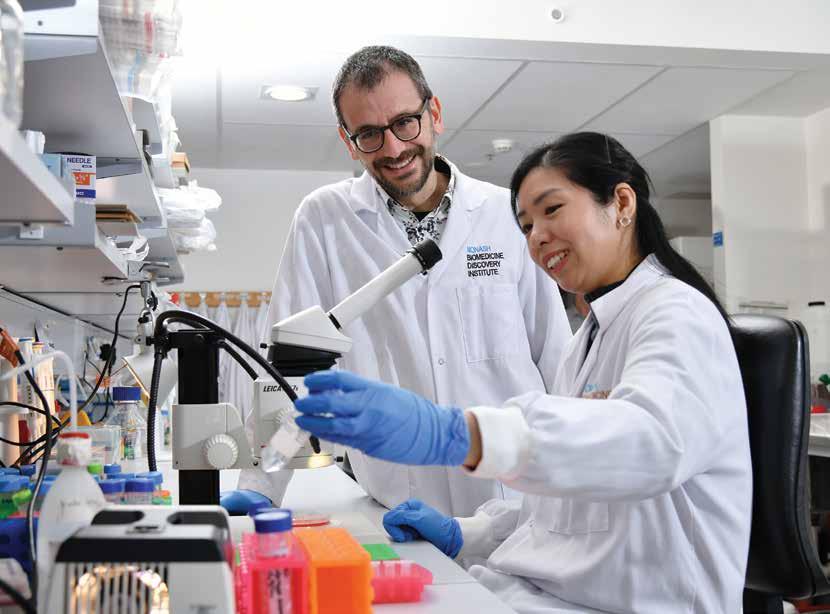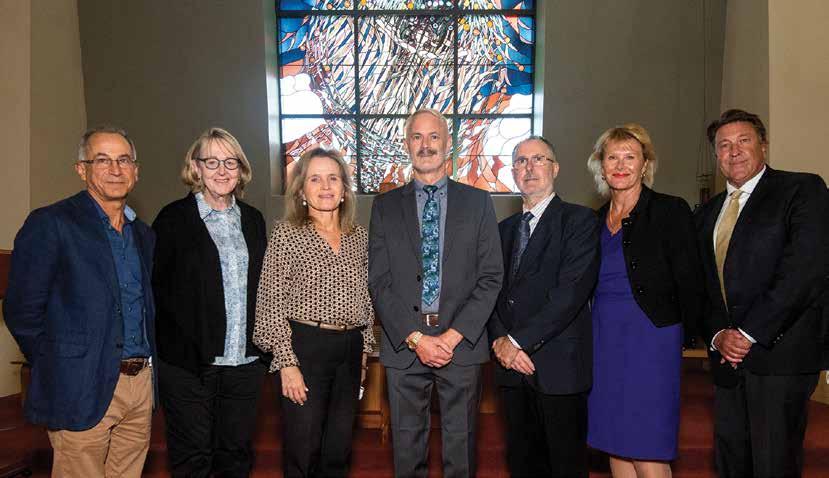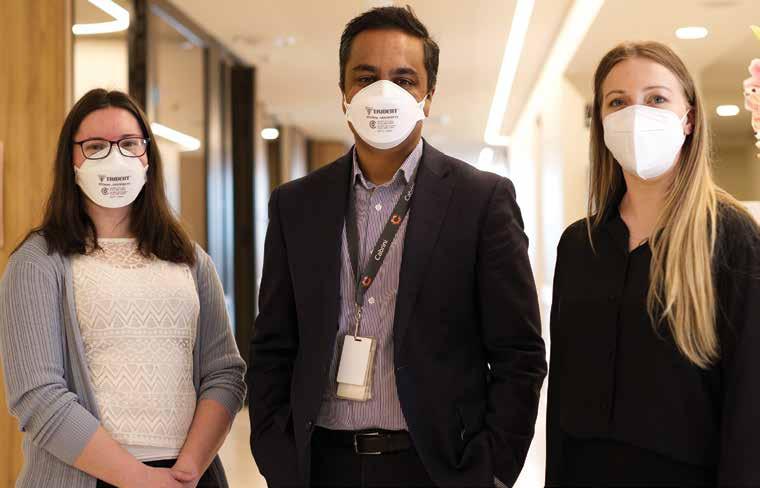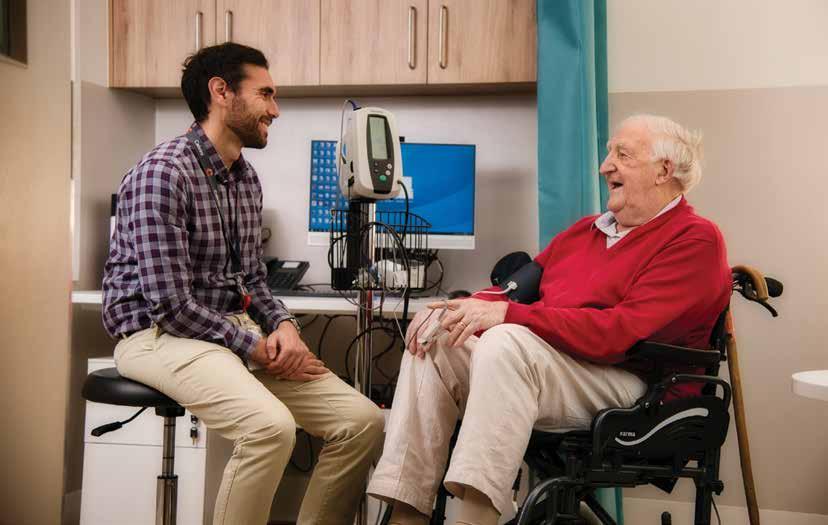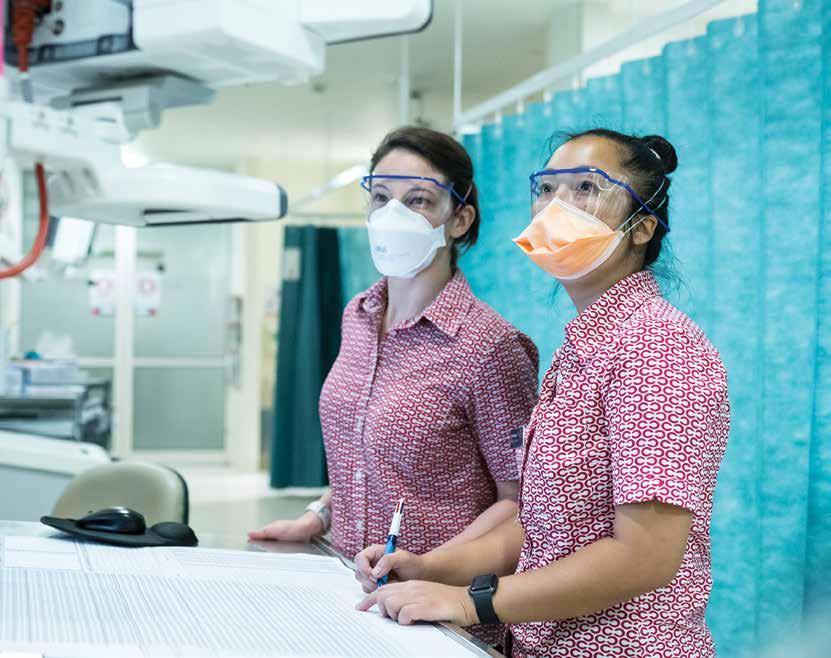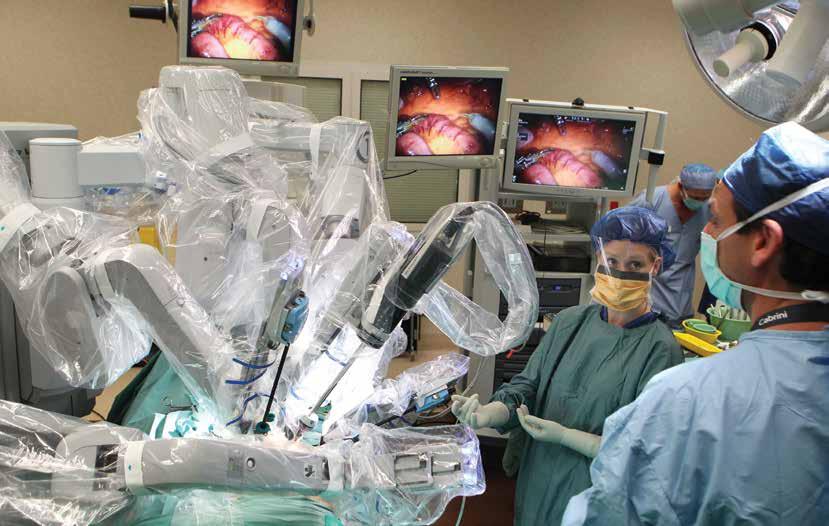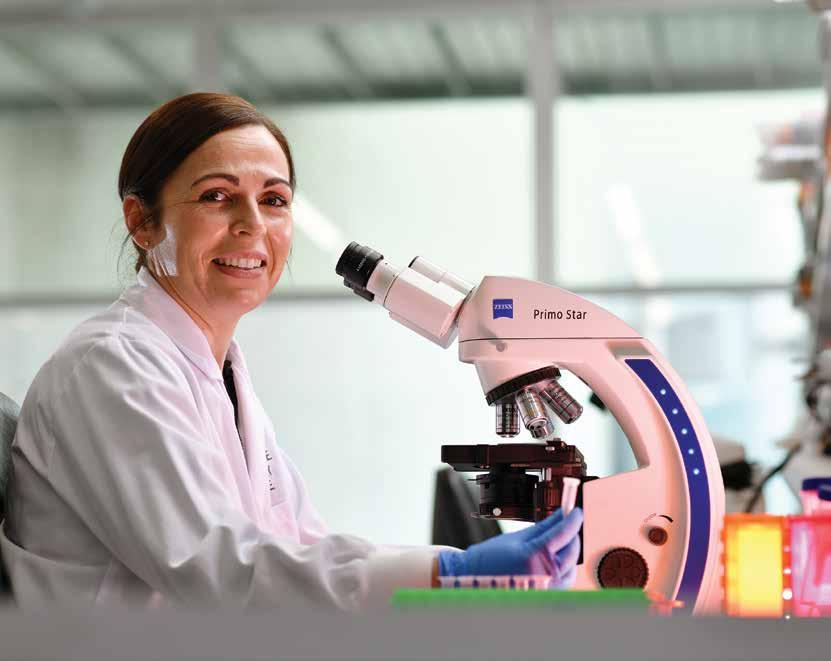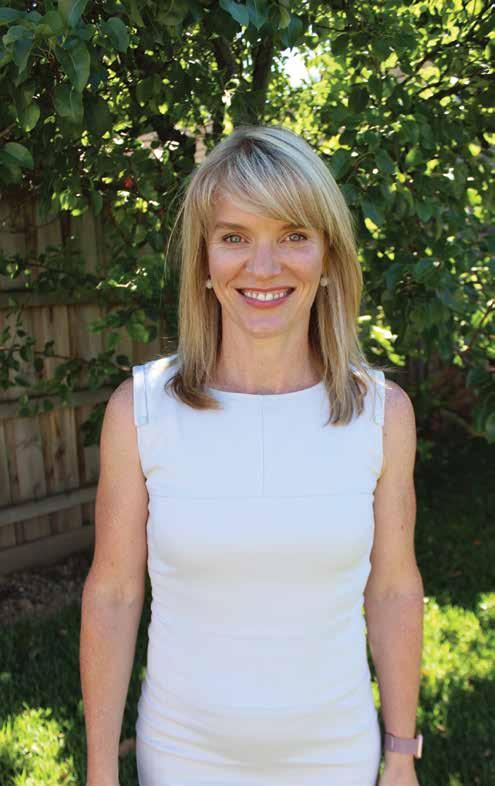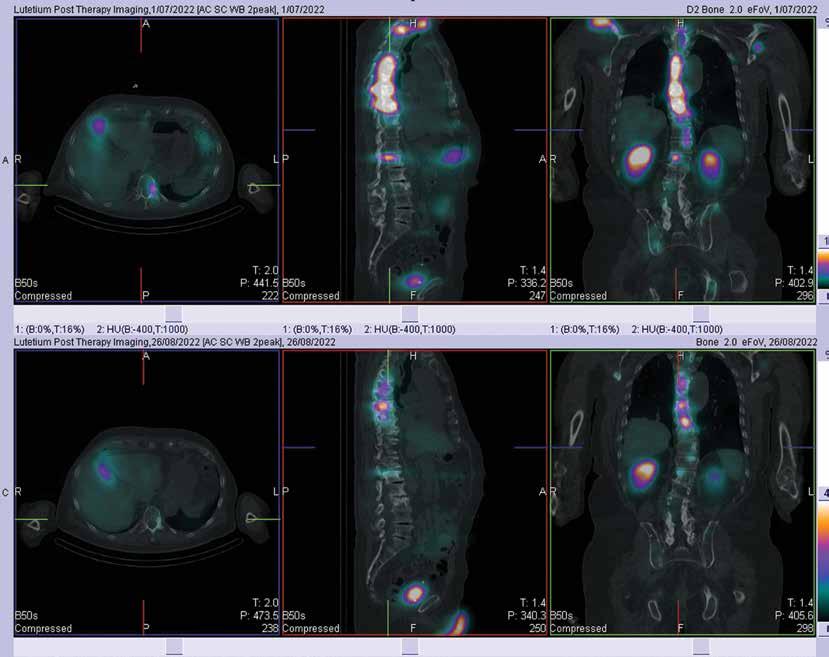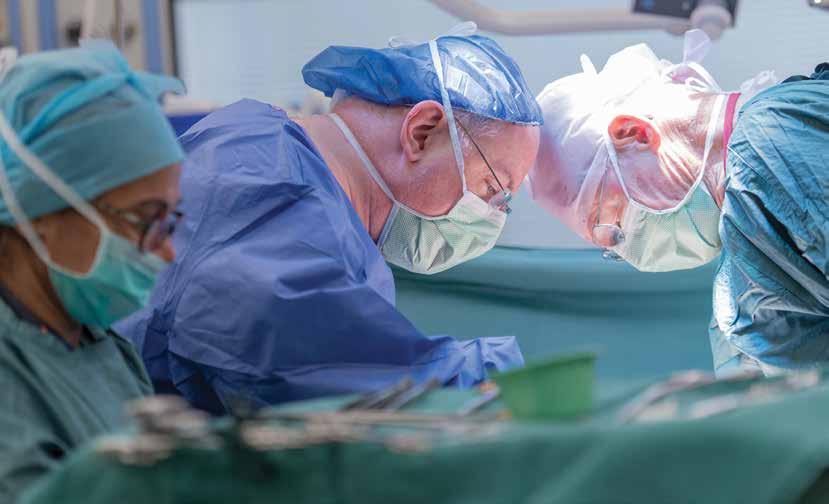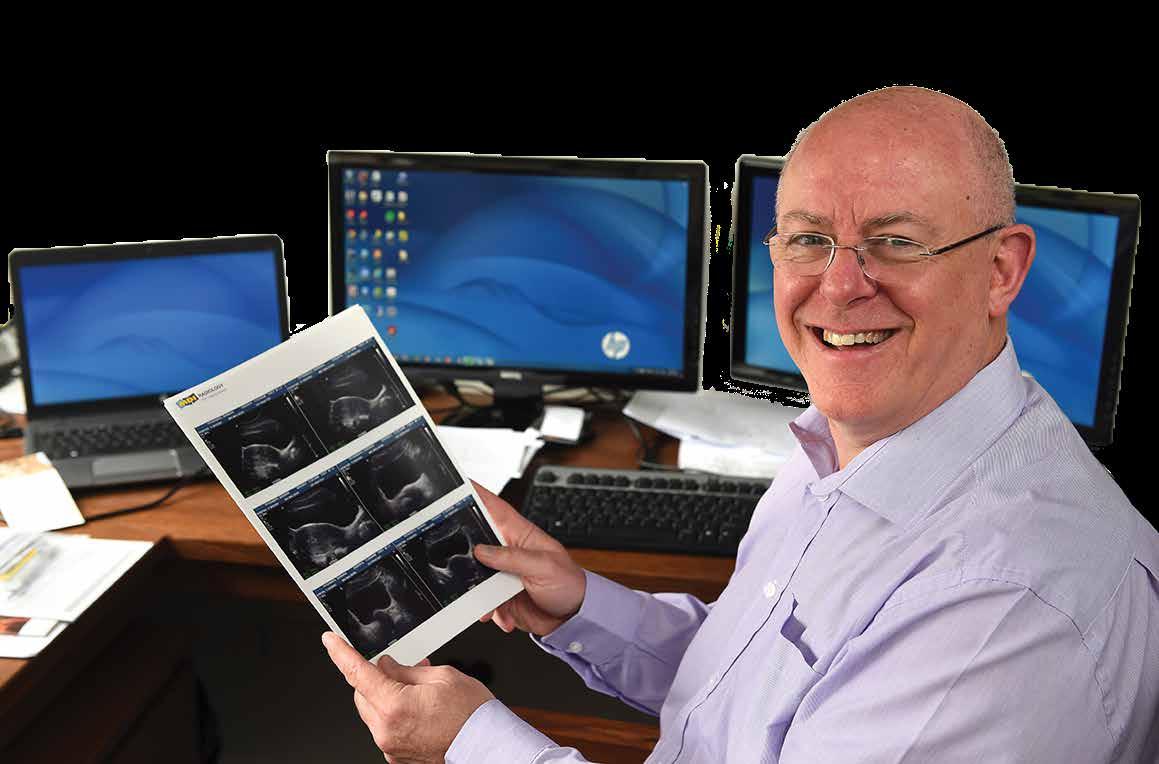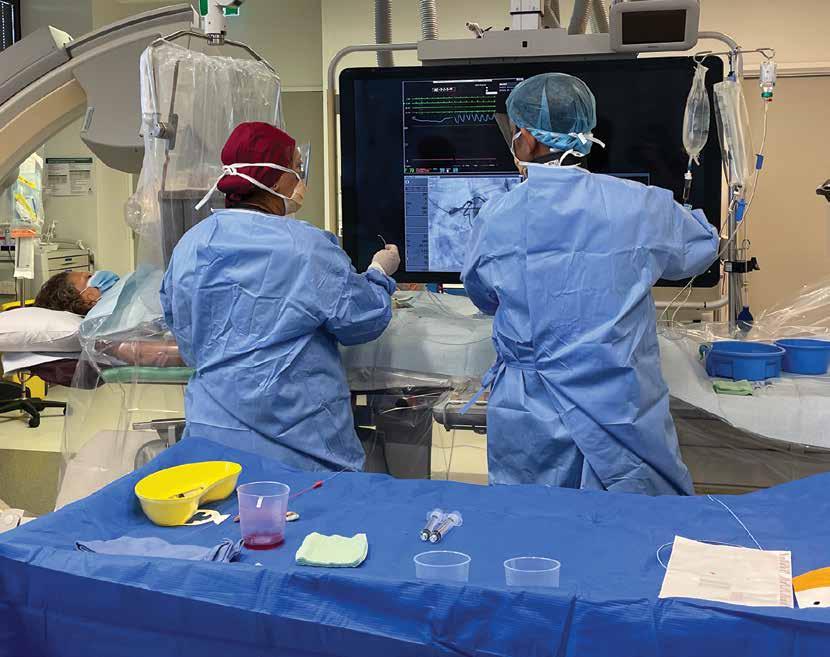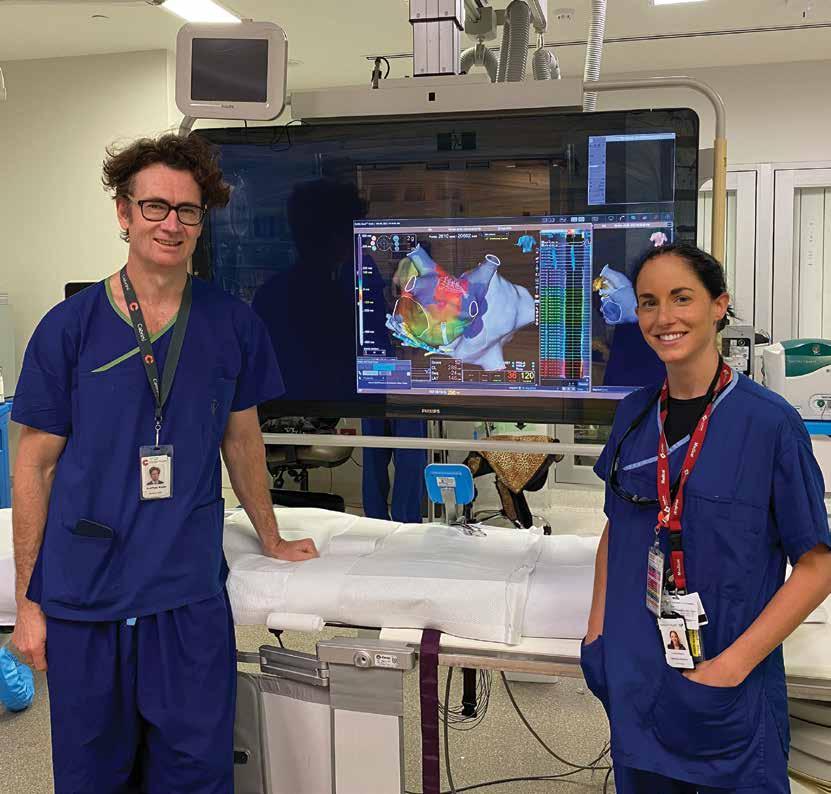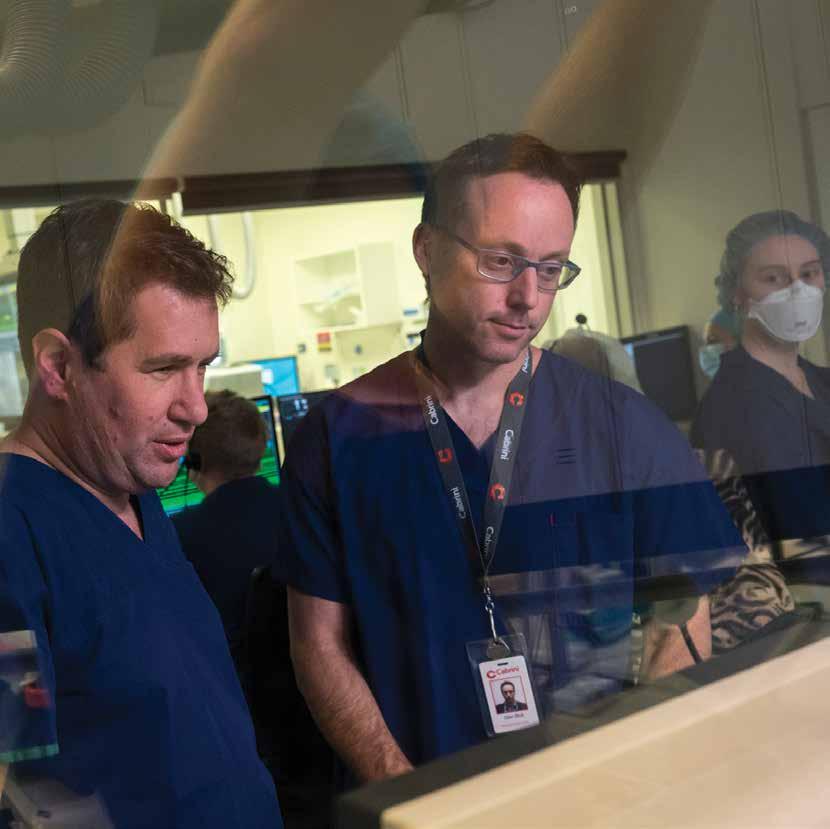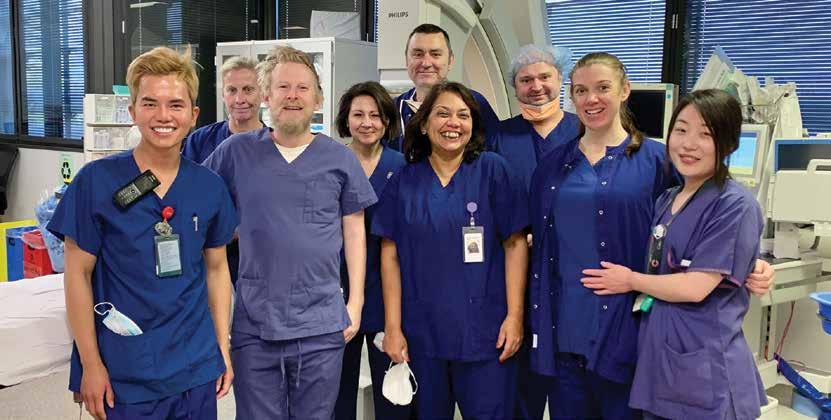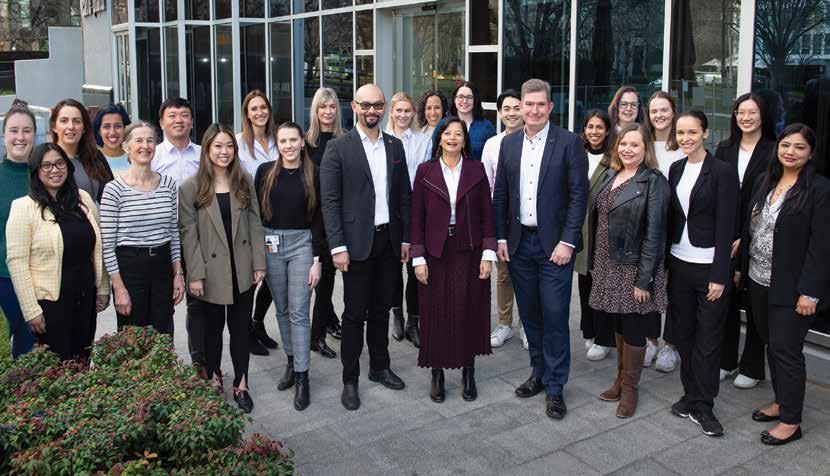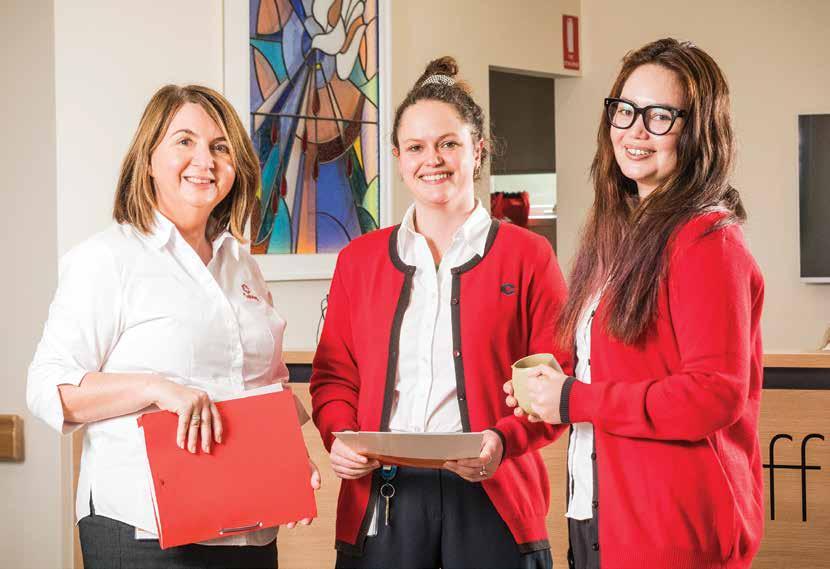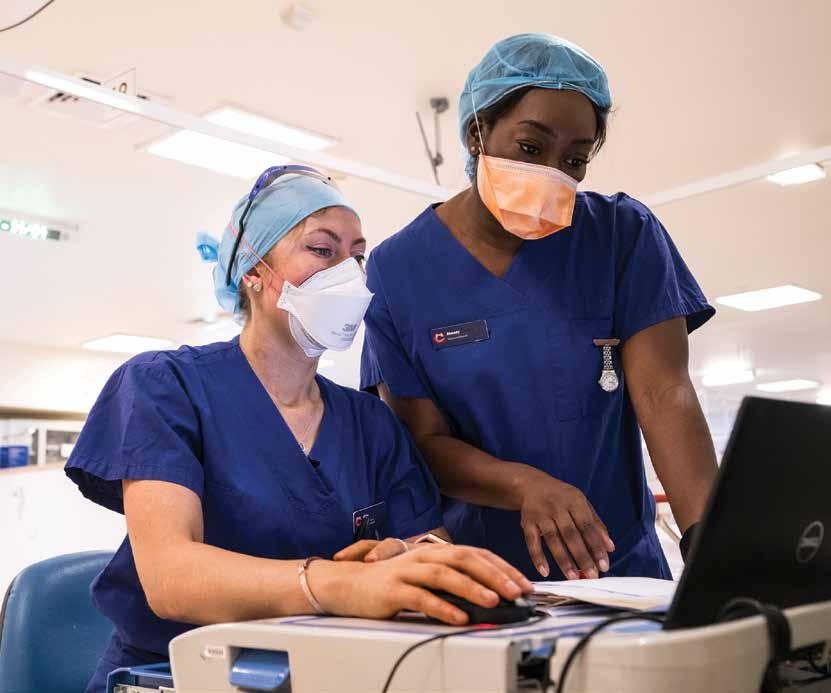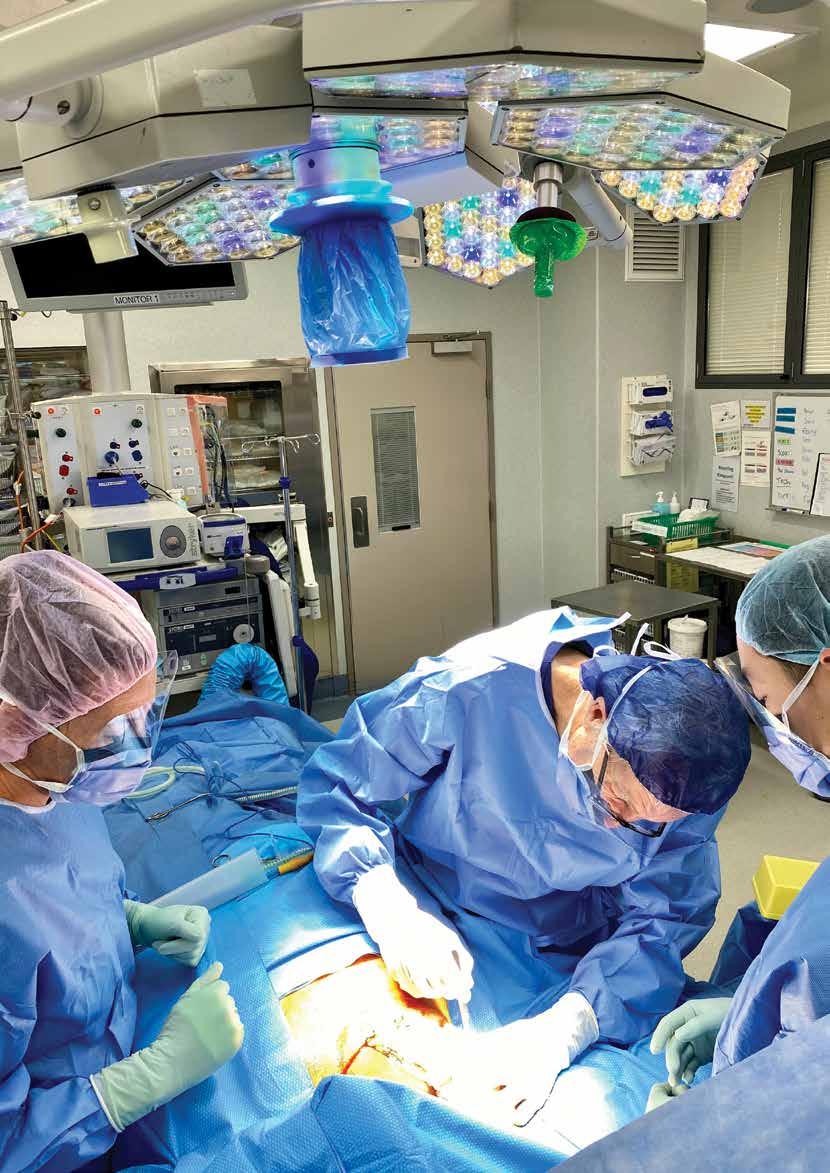Cabrini Research Governance
PROJECTS APPROVED 1 JULY 2021 TO 30 JUNE 2022
ALLIED HEALTH
Project title
Investigating malnutrition in Victorian cancer services: Malnutrition prevalence study 2022
Medication education survey for physiotherapists in Victoria
The rate of appropriate venous thromboembolism prophylaxis prescribing for newly admitted patients in a single tertiary hospital
BRAIN / NEUROSURGERY
Project title
Preoperative HbA1c levels and postoperative outcomes in neurosurgery - Pilot study
A multi-centre, prospective trial exploring the use of neuronal biomarkers to identify the ideal location to implant and apply Deep Brain Stimulation (DBS) in the treatment of Parkinson’s disease [ADEPT DBS][BI2021A]
A clinical feasibility study evaluating the BiRD at quantifying motor symptoms in people with Parkinson’s disease [BiRD-001]
BRAIN: Brain Registry Australia: Innovation and traNslation
CANCER
Project title
Principal investigator
Ms Bree Voegt
Mr Robert Wojnar
Mr Robert Wojnar
Principal investigator
Prof Gavin Davis
A/Prof Wesley Thevathasan
A/Prof Wesley Thevathasan
Dr Ron Freilich
To determine whether menopausal status is a predictor for toxicities that result in a change in or cessation of endocrine treatment in the setting of estrogen receptor positive, early breast cancer
A phase 1, open-label, dose-escalation and dose-expansion study evaluating the safety, tolerability, pharmacokinetics, pharmacodynamics, and preliminary efficacy of D3S-001 monotherapy in subjects with advanced solid tumours with a KRAS p.G12C mutation [D3S-001-100]
A phase 3, randomised, controlled, multicentre, open-label study to compare Tivozanib in combination with Nivolumab to Tivozanib monotherapy in subjects with renal cell carcinoma who have progressed following one or two lines of therapy where one line has an immune checkpoint inhibitor [TiNivo-2][AV951-20-304]
A phase 1/2, first-in-human, open-label, multicentre study evaluating the safety, tolerability, pharmacokinetics and efficacy of a trispecific EGFR/cMET/cMET antibody GB263T in subjects with advanced non-small cell lung cancer (NSCLC) and other solid tumors [GB263T-FIH001]
A phase 1/2, first-in-human, open-label, dose-escalation study of TAK-280 in patients with unresectable locally advanced or metastatic cancer [TAK-280-1501]
A multicentre, parallel arm, open-label trial of frontline R-CHOP/Pola-RCHP and glofitamab in younger, higher risk patients with diffuse large B cell lymphoma (DLBCL)[COALITION]
The impact of cigarette smoking on colorectal cancer surgery pathology, perioperative and longterm cancer outcomes
A phase 1 study of SRF617 in patients with advanced solid tumours [SRF617-101]
Principal investigator
Dr Michelle White
Prof Gary Richardson
Prof Mark Frydenberg
Prof Gary Richardson
Prof Gary Richardson
Dr Kirsten Herbert
Dr Lauren Cohen
Prof Gary Richardson
98 CABRINI RESEARCH | Annual Report 2021-22 PROJECTS
PROJECTS APPROVED 1 JULY 2021 TO 30 JUNE 2022
CANCER
Project title
A multicentre, open-label, phase I dose escalation study to evaluate the safety, tolerability, pharmacokinetics and preliminary anti-tumour activity of YH002 in combination with YH001 in subjects with advanced solid tumours [YH002004]
A phase I/II, open-label, multicentre study evaluating the safety, tolerability, pharmacokinetics and efficacy of GB261 in patients with relapsed or refractory B-cell non-Hodgkin lymphoma and chronic lymphocytic leukaemia [GB261-001]
A phase I/II, first-in-human (FIH), open-label, dose escalation and expansion study to evaluate the safety, tolerability, pharmacokinetics and preliminary efficacy of LM-108 (an Anti-CCR8 mAb) as a single agent or in combination with an anti-PD-1 antibody in subjects with advanced solid tumours [LM108-01-101]
Understanding pathways to bowel cancer early diagnosis and treatment - comparing under vs over 50s [UPBEAT 50]
Phase 1-2 study investigating, safety, tolerability, pharmacokinetics and preliminary antitumour activity of Anti-TIM-3 monoclonal antibody BGB-A425 in combination with anti-PD-1 monoclonal antibody Tislelizumab in patients with advanced solid tumours [BGB-900-102]
A first in human phase 1/2 open-label, multicentre, dose escalation and expansion study of PRS-344/ S095012 in patients with solid tumours [CL1-95012-001]
A phase 1 / 2 study of HLX301, a recombinant humanised anti-PDL1 and anti-TIGIT bispecific antibody, in patients with locally advanced or metastatic solid tumours [HLX301-001]
Lymphoma and Related Diseases Registry [LaRDR]
An ascending single and multiple dose study of the safety, tolerability, pharmacokinetics and anti-tumour activity of once-daily oral treatment with EO1001 in patients with advanced cancer [EOHC-1001-01]
A phase 2, single arm study of Mirvetuximab Soravtansine in recurrent platinum-sensitive, high grade epithelial ovarian, primary peritoneal, or fallopian tube cancers with high folate receptor alpha expression [IMGN853-0419] [PICCOLO]
An open-label, multicentre, phase 2 study to evaluate the efficacy and safety of Pembrolizumab plus Lenvatinib in combination with Belzutifan in multiple solid tumours [MK-6482-016]
Principal investigator
Prof Gary Richardson
A/Prof Melita Kenealy
Prof Gary Richardson
Prof Paul McMurrick
Prof Gary Richardson
Prof Gary Richardson
Prof Gary Richardson
A/Prof Melita Kenealy
Prof Gary Richardson
Prof Gary Richardson
Dr Lucy Gately
KRAS: Prevalence and clinical outcomes of KRASG12C mutated advanced lung cancer patients in Australia Dr Ben Markman
A first-in-human phase 1 study of NL-201 in patients with relapsed or refractory cancer [NL201- 101] Prof Gary Richardson
Cabrini lung cancer database Prof Gary Richardson
A phase III, open label, randomised, 3-arm, multi-centre study of Savolitinib plus Durvalumab versus Sunitinib and Savolitinib plus Durvalumab versus Durvalumab monotherapy in participants with MET driven, unresectable and locally advanced or metastatic papillary renal cell carcinoma (PRCC) [D5086C00001] [SAMETA]
A multi-centre, single-arm and open-label phase Ib/II study exploring the safety/tolerability, pharmacokinetics and efficacy of GFH018 in combination with Toripalimab in the treatment of patients with advanced solid tumours [GFH018X0201]
A phase 1/2a open label, dose escalation and expansion study of MDNA11, IL-2 superkine, administered alone or in combination with immune checkpoint inhibitor in patients with advanced solid tumours [MDNA11-01][ABILITY]
Phase 1b/2a study investigating ATX101 in combination with platinum based therapy in recurrent ovarian, fallopian tube and primary peritoneal cancer [ATX101-03]
Prof Mark Frydenberg
Prof Gary Richardson
Prof Gary Richardson
Prof Gary Richardson
99 CABRINI RESEARCH | Annual Report 2021-22 PROJECTS
PROJECTS APPROVED 1 JULY 2021 TO 30 JUNE 2022
CANCER
Project title
Phase 3, randomised, open-label study to compare ociperlimab (BGB-A1217) plus Tislelizumab (BGB-A317) plus concurrent chemoradiotherapy (cCRT) followed by Ociperlimab plus Tislelizumab or Tislelizumab plus cCRT followed by Tislelizumab versus cCRT followed by Durvalumab in previously untreated, locally advanced, unresectable nonsmall cell lung cancer [BGB-A317-A1217-301 (AdvanTIG-301)]
Using polygenic risk modification to improve breast cancer prevention: The PRiMo trial
A phase 1, multi-centre, open-label study to assess safety, tolerability, pharmacokinetics, and preliminary efficacy of BAT6021 as mono therapy or in combination with BAT1308 in patients with advanced solid tumours [BAT-6021-002-CR]
Quality control survey for the BCCA
A first-in-human, multicentre, open-label, phase I dose escalation study to evaluate the safety, tolerability and pharmacokinetics of YH004 as a single agent and combination with toripalimab in subjects with advanced solid tumours and relapsed or refractory non-Hodgkin lymphoma [YH004002]
A randomised, double-blinded, placebo-controlled, multicentre, phase II study to evaluate Senaparib maintenance in mCRPC patients with homologous recombination repair gene alterations after docetaxel treatment [IMP4297-202]
Colorectal cancer in the under 50’s: is it time to revisit the guidelines for screening?
A first-in-human, phase I/II, open-label study to evaluate the safety, tolerability, pharmacokinetics and preliminary antitumour activity of EMB-06 in patients with relapsed or refractory multiple myeloma [EMB06X101]
Principal investigator
Dr Ben Markman
A/Prof Yoland Antill
Dr Anis Hamid
Dr Raymond Yap
Dr Anis Hamid
Dr David Pook
Dr Simon Wilkins
A/Prof Melita Kenealy
Patients that don’t receive adjuvant chemotherapy for stage III colon cancer: are we making the right call? Dr Christine Koulis
A phase 3, randomised, double-blind study of Trilaciclib or placebo in patients receiving first or second line Gemcitabine and Carboplatin chemotherapy for locally advanced unresectable or metastatic triplenegative breast cancer [G1T28-208] [PRESERVE 2]
A phase I, first-in-human, multicentre, open-label study of RC118 for injection in patients with locally advanced unresectable/metastatic solid tumours [RC118-G001]
A phase 3, randomised, double-blind, study of talazoparib with enzalutamide versus placebo with enzalutamide in men with DDR gene mutated metastatic castration-sensitive prostate cancer [TALAPRO-3] [C3441052]
Phase 2 study evaluating the efficacy and safety of biomarker-driven therapies in patients with persistent or recurrent rare epithelial ovarian tumours [WO42178] [BOUQUET]
A phase 1 first in human, multicentre, open-label study to determine the safety, tolerability, pharmacokinetics, and recommended phase 2 dose of CCX559 in subjects with solid tumours [CL001_559]
A multicentre, randomised, double-blind, placebo-controlled study to assess the safety and preliminary efficacy of SIR1-365 in patients with chronic prostatitis / chronic pelvic pain syndrome [SIR365-AU-102]
MOR208C310 - A phase 3, multicentre, randomised, double-blind, placebo-controlled trial comparing the efficacy and safety of tafasitamab plus lenalidomide in addition to R-CHOP versus R-CHOP in previously untreated, high-intermediate and high-risk patients with newly diagnosed diffuse large B-cell lymphoma (DLBCL)
A randomised, open-label phase 2 clinical trial of BMS-986012 in combination with carboplatin, etoposide, and nivolumab as first-line therapy in extensive stage small cell lung cancer [CA001- 050]
A phase 1, first in human, open-label dose escalation clinical trial to evaluate the safety, tolerability, pharmacokinetics and preliminary efficacy of LM-061 tablet in subjects with advanced tumours [LM061-01102]
A/Prof Yoland Antill
Prof Gary Richardson
Prof Mark Frydenberg
Prof Gary Richardson
Prof Gary Richardson
Prof Mark Frydenberg
A/Prof Melita Kenealy
Dr Ben Markman
Prof Gary Richardson
Treatment trends and patterns of care of active surveillance in a Victorian cohort of men [GAP3] Prof Mark Frydenberg
100 CABRINI RESEARCH | Annual Report 2021-22
PROJECTS
PROJECTS APPROVED 1 JULY 2021 TO 30 JUNE 2022
CARDIAC
Project title
Routine versus selective protamine administration to reduce bleeding in transcatheter aortic valve implantation [ACE PRO-TAVI]
IV iron for treatment of anaemia before cardiac surgery [ITACS]
Dexamethasone for cardiac surgery trial: a registry based, novel practice preference, randomised design
Catheter ablation versus medical rate control in atrial fibrillation with systolic heart failure and myocardial fibrosis – an MRI guided multi-centre randomised controlled trial (CAMERA-MRI II)
The Australian New Zealand spontaneous coronary artery dissection registry [ANZ-SCAD]
An evaluation of blood pressure pre and post echocardiogram in an adult population
HEALTH INFORMATICS
Project title
Review of documentation quality across episode of care in cases with delirium at Cabrini hospital
Quarterly reporting: sensemaking and feedback
Impact of COVID-19 on admissions to hospital
How do physicians and surgeons make sense of clinical performance indicators derived from electronic health data?
Correlation between infections, delirium, charlson score and falls
Reconciliation of medication records
Demographic profile of patients who raise complaints
Review of the patients who developed urinary tract infections while in hospital
INTENSIVE CARE
Project title
Review of post operative pain in minimally invasive cardiac surgery as compared to traditional median sternotomy in Cabrini ICU
Oxygenation Terminology Study
Patient load sharing between two ICUs during a pandemic - including non COVID-19 overflow patients
International point prevalence study of intensive care unit transfusion practices [InPUT study]
investigator
A/Prof Dion Stub
Dr Mark Shulman
Dr Mark Shulman
Prof Peter Kistler
Dr Swati Mukherjee
Mr Joshua Sher
Dr David Rankin
Dr David Rankin
Dr David Rankin
Dr David Rankin
Dr David Rankin
Dr David Rankin
Dr David Rankin
Dr David Rankin
Vineet Sarode
David Brewster
David Brewster
David Brewster
101 CABRINI RESEARCH | Annual Report 2021-22
Principal
Principal
investigator
Principal
investigator
A/Prof
A/Prof
A/Prof
A/Prof
PROJECTS
PROJECTS APPROVED 1 JULY 2021 TO 30 JUNE 2022
MUSCULOSKELETAL
Project title
Implementation intervention to increase intake of rehabilitation-at-home following a primary elective total hip and knee replacement surgery at a private hospital - A randomised controlled trial
Australian and New Zealand Hip Fracture Registry [ANZHFR]
NURSING
Project title
Barriers and facilitators to nurses research involvement
What is regarded higher by qualified nurses undertaking postgraduate or graduate education, workbased learning or classroom-based education?
The accuracy of coded hospital acquired complication data in identifying healthcare associated infections
OTHER
Project title
Vaginal stem cells: the missing link in vaginal reconstruction
Most rejected x-ray images in a private hospital’s general radiography department: retrospective learnings from common errors
Novel ocular biomarkers in diabetes
A study to assess the genotype of subjects with diagnoses of ulcerative colitis or crohn’s diseaseThe Prelude study
A retrospective audit of ‘code grey’ emergency response calls at Cabrini Malvern
Make my values matter - Developing and testing of a values question prompt list for advanced cancer patients
A randomised controlled single blinded multicentre trial of polyethylene glycol sealant to the staple line vs staple line alone in distal pancreatectomy [PEGDP-01]
A phase 2 double-blind, randomised, placebo controlled study to evaluate the efficacy, safety and tolerability of PF-06823859 in adult subjects with dermatomyositis [C0251002]
Evaluation and safety and efficacy of the IBE-814 intravitreal implant in patients with diabetic macular oedema and macular oedema due to retinal vein occlusion [RIPPLE-1]
This is my story: Hope and human flourishing through workplace opportunities
Psychocultural and practical factors related to Australian adults’ comprehension and utilisation of overtesting and overdiagnosis information
Principal investigator
Dr Jason Wallis
A/Prof Marinis Pirpiris
Principal investigator
Dr Lucille Kerr
Mr Rick Peebles
A/Prof Philip Russo
Principal investigator
A/Prof Anna Rosamilia
Mr Kris Ockwell
A/Prof R C Andrew Symons
A/Prof Henry Debinski
A/Prof Michael Rose
A/Prof Natasha Michael
A/Prof Charles Pilgrim
Prof Stephen Hall
A/Prof R C Andrew Symons
A/Prof Natasha Michael
Dr Tom Rozbroj
102 CABRINI RESEARCH | Annual Report 2021-22 PROJECTS
Publications
CABRINI MONASH UNIVERSITY DEPARTMENT OF MEDICAL ONCOLOGY
Afshar N, Dashti SG, Te Marvelde L, Blakely T, Haydon A, White VM, Emery JD, Bergin RJ, Whitfield K, Thomas RJS, Giles GG, Milne RL, English DR. (2021) Factors Explaining Socio-Economic Inequalities in Survival from Colon Cancer: A Causal Mediation Analysis. Cancer Epidemiol Biomarkers Prev 30(10):1807-1815.
Antill Y, Buchanan DD, Scott CL. (2022) Mismatch repair and clinical response to immune checkpoint inhibitors in endometrial cancer. Cancer 128(6):1157-1161.
Bakshi A, Riaz M, Orchard SG, Carr PR, Joshi AD, Cao Y, Rebello R, Nguyen-Dumont T, Southey MC, Millar JL, Gately L, Gibbs P, Ford LG, Parnes HL, Chan AT, McNeil JJ, Lacaze P. (2021) A Polygenic Risk Score Predicts Incident Prostate Cancer Risk in Older Men but Does Not Select for Clinically Significant Disease. Cancers (Basel) 13(22):5815. doi: 10.3390/cancers13225815.
Baumann FT, Reimer N, Gockeln T, Reike A, Hallek M, Ricci C, Zopf EM, Schmid D, Taaffe D, Newton RU, Galvao DA, Leitzmann M. (2021) Supervised pelvic floor muscle exercise is more effective than unsupervised pelvic floor muscle exercise at improving urinary incontinence in prostate cancer patients following radical prostatectomy - a systematic review and metaanalysis. Disabil Rehabil 1-12. doi: 10.1080/09638288.2021.1937717.
Bishop MR, Dickinson M, Purtill D, Barba P, Santoro A, Hamad N, Kato K, Sureda A, Greil R, Thieblemont C, Morschhauser F, Janz M, Flinn I, Rabitsch W, Kwong YL, Kersten MJ, Minnema MC, Holte H, Chan EHL, Martinez-Lopez J, Müller AMS, Maziarz RT, McGuirk JP, Bachy E, Le Gouill S, Dreyling M, Harigae H, Bond D, Andreadis C, McSweeney P, Kharfan-Dabaja M, Newsome S, Degtyarev E, Awasthi R, Del Corral C, Andreola G, Masood A, Schuster SJ, Jäger U, Borchmann P, Westin JR. (2022) Second-Line Tisagenlecleucel or Standard Care in Aggressive B-Cell Lymphoma. N Engl J Med 386(7):629-639. doi: 10.1056/ NEJMoa2116596.
Bland KA, Kouw IWK, van Loon LJC, Zopf EM, Fairman CM. (2022) Exercise-Based Interventions to Counteract Skeletal Muscle Mass Loss in People with Cancer: Can We Overcome the Odds? Sports Med 52(5):1009-1027. doi: 10.1007/s40279-021-01638-z.
Bland KA, Krishnasamy M, Parr EB, Mulder S, Martin P, van Loon LJC, Cormie P, Michael N, Zopf EM. (2022) “I want to get myself as fit as I can and not die just yet” - Perceptions of exercise in people with advanced cancer and cachexia: a qualitative study. BMC Palliat Care 21(1):75. doi: 10.1186/s12904-022-00948-x.
Bland KA, Neil-Sztramko SE, Zadravec K, Medysky ME, Kong J, Winters-Stone KM, Campbell KL. (2021) Attention to principles of exercise training: an updated systematic review of randomized controlled trials in cancers other than breast and prostate. BMC Cancer 21(1):1179. doi: 10.1186/s12885-021-08701-y.
Bland KA, Neil-Sztramko SE, Zadravec K, Medysky ME, Kong J, Winters-Stone KM, Campbell KL. (2022) Correction to: Attention to principles of exercise training: an updated systematic review
of randomized controlled trials in cancers other than breast and prostate. BMC Cancer 22(1):182. doi: 10.1186/s12885-02109022-w.
Bröske AE, Korfi K, Belousov A, Wilson S, Ooi CH, Bolen CR, Canamero M, Alcaide EG, James I, Piccione EC, Carlile DJ, Dimier N, Umaña P, Bacac M, Weisser M, Dickinson M. (2022) Pharmacodynamics and molecular correlates of response to glofitamab in relapsed/refractory nonHodgkin lymphoma. Blood Adv 6(3):1025-1037. doi: 10.1182/ bloodadvances.2021005954.
Caldwell I, Byrne D, Lade S, Akhurst T, Minson A, Dickinson M, Thompson E, Scott C, Blombery P. (2021) Response to everolimus in a patient with refractory HGBL-NOS harboring multiple genomic aberrations in PTEN. Leuk Lymphoma 62(14):3521-3525. doi: 10.1080/10428194.2021.1965139.
Chee L, Ritchie D, Ludford-Menting M, Ripley J, Chung J, Park D, Norton S, Kenealy M, Koldej R. (2022) Dysregulation of immune cell and cytokine signalling correlates with clinical outcomes in myelodysplastic syndrome (MDS). Eur J Haematol 108(4):342353. doi: 10.1111/ejh.13742.
Cherk MH, Nadebaum DP, Barber TW, Beech P, Haydon A, Yap KS. (2022) 18 F-FDG PET/CT features of immune-related adverse events and pitfalls following immunotherapy. J Med Imaging Radiat Oncol 66(4):483-494. doi: 10.1111/1754-9485.13390.
Chew NJ, Lim Kam Sian TCC, Nguyen EV, Shin SY, Yang J, Hui MN, Deng N, McLean CA, Welm AL, Lim E, Gregory P, Nottle T, Lang T, Vereker M, Richardson G, Kerr G, Micati D, Jardé T, Abud HE, Lee RS, Swarbrick A, Daly RJ. (2021) Evaluation of FGFR targeting in breast cancer through interrogation of patientderived models. Breast Cancer Res 23(1):82.
Chong CY, Jalali A, Wong HL, Loft M, Wong R, Lee M, Gately L, Hong W, Shapiro J, Kosmider S, Tie J, Ananda S, Yeung JM, Ma B, Burge M, Jennens R, Tran B, Lee B, Lim L, Dean A, Nott L, Gibbs P. (2022) Impact of the evolution in RAS mutation analysis in Australian patients with metastatic colorectal cancer. Asia Pac J Clin Oncol doi: 10.1111/ajco.13728.
Cochrane T, Campbell BA, Gangatharan SA, Latimer M, Khor R, Christie DRH, Gilbertson M, Ratnasingam S, Palfreyman E, Lee HP, Trotman J, Hertzberg M, Dickinson M. (2021) Assessment and management of newly diagnosed classical Hodgkin lymphoma: a consensus practice statement from the Australasian Lymphoma Alliance. Intern Med J 51(12):2119-2128. doi: 10.1111/imj.15503.
Czosnek L, Rosenbaum S, Rankin NM, Zopf EM, Cormie P, Herbert B, Richards J. (2022) Implementation of physical activity interventions in a community-based youth mental healthcare service: A case study of context, strategies, and outcomes. Early Interv Psychiatry doi: 10.1111/eip.13324.
da Silva IP, Ahmed T, Reijers ILM, Warner AB, Patrinely JR, SerraBellver P, Allayous C, Mangana J, Zimmer L, Trojaniello C, Klein O, Gerard CL, Michielin O, Haydon A, Ascierto PA, Carlino MS,
103 CABRINI RESEARCH | Annual Report 2021-22
Lebbe C, Lorigan P, Johnson DB, Sandhu S, Lo SN, Menzies AM, Long GV. (2021) Ipilimumab versus ipilimumab plus antiPD-1 for metastatic melanoma - Authors’ reply. Lancet Oncol 22(8):e343-e344.
Degeling K, Corcoran NM, Pereira-Salgado A, Hamid AA, Siva S, IJzerman MJ. (2021) Lifetime Health and Economic Outcomes of Active Surveillance, Radical Prostatectomy, and Radiotherapy for Favorable-Risk Localized Prostate Cancer. Value Health 24(12):1737-1745.
Dickinson M. (2022) Challenges in the development of bispecific antibodies for non-Hodgkin lymphoma. Lancet Haematol 9(5):e314-e315. doi: 10.1016/S2352-3026(22)00104-1.
Dickinson M, Briones J, Herrera AF, González-Barca E, Ghosh N, Cordoba R, Rutherford SC, Bournazou E, Labriola-Tompkins E, Franjkovic I, Chesne E, Brouwer-Visser J, Lechner K, Brennan B, Nüesch E, DeMario M, Rüttinger D, Kornacker M, Hutchings M. (2021) Phase 1b study of the BET protein inhibitor RO6870810 with venetoclax and rituximab in patients with diffuse large B-cell lymphoma. Blood Adv 5(22):4762-4770. doi: 10.1182/ bloodadvances.2021004619.
Dinh P, Graham JD, Elder EN, Kabir M, Doan TB, French J, Meybodi F, Hui R, Wilcken NR, Harnett PR, Hsu J, Stuart KE, Wang T, Ahern V, Brennan M, Fox SB, Dear RF, Lim E, White M, Mann GB, Pathmanathan N. (2022) Impact of the EndoPredict genomic assay on treatment decisions for oestrogen receptorpositive early breast cancer patients: benefits of physician selective testing. Breast Cancer Res Treat 191(3):501-511. doi: 10.1007/s10549-021-06456-5.
Dunn C, Gately L, Gibbs P. (2021) Drinking from the firehose - A clinician’s perspective on the challenges of delivering biomarker-driven care in routine practice. Eur J Cancer 157:301305. doi: 10.1016/j.ejca.2021.08.037.
Dunn C, Gately L, Gibbs P. (2022) Comment on Timing of Surgery For Patients With Rectal Cancers Not Responding to Preoperative Chemoradiation. JAMA Surg 157(6):548-549. doi: 10.1001/jamasurg.2021.7590.
Febrina F, Triyoga IF, White M, Marino JL, Peate M. (2022) Efficacy of interventions to manage sexual dysfunction in women with cancer: a systematic review. Menopause 29(5):609-626. doi: 10.1097/GME.0000000000001953.
Foo T, Goldstein D, Segelov E, Shapiro J, Pavlakis N, Desai J, Yip D, Zalcberg J, Price TJ, Nagrial A, Chantrill L, Burge M, Karapetis CS, Tebbutt N, Roy AC. (2022) The Management of Unresectable, Advanced Gastrointestinal Stromal Tumours. Target Oncol 17(2):95-110. doi: 10.1007/s11523-022-00869-y.
Fowler NH, Dickinson M, Dreyling M, Martinez-Lopez J, Kolstad A, Butler J, Ghosh M, Popplewell L, Chavez JC, Bachy E, Kato K, Harigae H, Kersten MJ, Andreadis C, Riedell PA, Ho PJ, PérezSimón JA, Chen AI, Nastoupil LJ, von Tresckow B, Ferreri AJM, Teshima T, Patten PEM, McGuirk JP, Petzer AL, Offner F, Viardot A, Zinzani PL, Malladi R, Zia A, Awasthi R, Masood A, Anak O,
Schuster SJ, Thieblemont C. (2022) Tisagenlecleucel in adult relapsed or refractory follicular lymphoma: the phase 2 ELARA trial. Nat Med 28(2):325-332. doi: 10.1038/s41591-021-01622-0.
Fujihara KM, Corrales Benitez M, Cabalag CS, Zhang BZ, Ko HS, Liu DS, Simpson KJ, Haupt Y, Lipton L, Haupt S, Phillips WA, Clemons NJ. (2021) SLC7A11 Is a Superior Determinant of APR-246 (Eprenetapopt) Response than TP53 Mutation Status. Mol Cancer Ther 20(10):1858-1867. doi: 10.1158/1535-7163.MCT-21-0067.
Gately L, Drummond K, Rosenthal M, Harrup R, Dowling A, Gogos A, Lwin Z, Collins I, Campbell D, Ahern E, Phillips C, Gan HK, Bennett I, Sieber OM, Gibbs P. (2022) Beyond standard data collection - the promise and potential of BRAIN (Brain tumour Registry Australia INnovation and translation registry). BMC Cancer 22(1):604. doi: 10.1186/s12885-022-09700-3.
Gaughran G, Zalcberg J, Hawkins CA, Shackleton M, Voskoboynik M. (2021) Improving regional access: Phase 1 teletrials in the era of COVID-19. Asia Pac J Clin Oncol 17(4):416417. doi: 10.1111/ajco.13558.
Gould C, Lickiss J, Kankanige Y, Yerneni S, Lade S, Gandhi MK, Chin C, Yannakou CK, Villa D, Slack GW, Markham JF, Tam CS, Nelson N, Seymour JF, Dickinson M, Neeson PJ, Westerman D, Blombery P. (2021) Characterisation of immune checkpoints in Richter syndrome identifies LAG3 as a potential therapeutic target. Br J Haematol 195(1):113-118. doi: 10.1111/bjh.17789.
Gregory G, Das Gupta K, Meiser B, Barlow-Stewart K, GeelanSmall P, Kaur R, Scheepers-Joynt M, McInerny S, Taylor S, Antill Y, Salmon L, Smyth C, Young MA, James PA, Yanes T. (2022) Polygenic risk in familial breast cancer: Changing the dynamics of communicating genetic risk. J Genet Couns 31(1):120-129.
Halle BR, Betof Warner A, Zaman FY, Haydon A, Bhave P, Dewan AK, Ye F, Irlmeier R, Mehta P, Kurtansky NR, Lacouture ME, Hassel JC, Choi JS, Sosman JA, Chandra S, Otto TS, Sullivan R, Mooradian MJ, Chen ST, Dimitriou F, Long G, Carlino M, Menzies A, Johnson DB, Rotemberg VM. (2021) Immune checkpoint inhibitors in patients with pre-existing psoriasis: safety and efficacy. J Immunother Cancer 9(10):e003066.
Hepner A, Atkinson VG, Larkin J, Burrell RA, Carlino MS, Johnson DB, Zimmer L, Tsai KK, Klein O, Lo SN, Haydon A, Bhave P, Lyle M, Pallan L, Pires da Silva I, Gerard C, Michielin O, Long GV, Menzies AM. (2021) Re-induction ipilimumab following acquired resistance to combination ipilimumab and anti-PD-1 therapy. Eur J Cancer 153:213-222.
Kelly R, Anton A, Wong S, Shapiro J, Weickhardt A, Azad A, Kwan EM, Spain L, Muthusamy A, Torres J, Parente P, Parnis F, Goh J, Joshua A, Pook D, Baenziger O, Gibbs P, Tran B. (2021) Realworld use of first-generation antiandrogens: impact on patient outcomes and subsequent therapies in metastatic castrationresistant prostate cancer. BJU Int 128 Suppl 1:18-26. doi: 10.1111/ bju.15364.
Kennedy OJ, Kicinski M, Valpione S, Gandini S, Suciu S, Blank CU, Long GV, Atkinson VG, Dalle S, Haydon AM, Meshcheryakov
104 CABRINI RESEARCH | Annual Report 2021-22
PUBLICATIONS
A, Khattak A, Carlino MS, Sandhu S, Larkin J, Puig S, Ascierto PA, Rutkowski P, Schadendorf D, Koornstra R, HernandezAya L, Di Giacomo AM, van den Eertwegh AJM, Grob JJ, Gutzmer R, Jamal R, van Akkooi ACJ, Robert C, Eggermont AMM, Lorigan P, Mandala M. (2022) Prognostic and predictive value of β-blockers in the EORTC 1325/KEYNOTE-054 phase III trial of pembrolizumab versus placebo in resected high-risk stage III melanoma. Eur J Cancer 165:97-112. doi: 10.1016/j. ejca.2022.01.017.
Khan NN, Maharaj A, Evans S, Pilgrim C, Zalcberg J, Brown W, Cashin P, Croagh D, Michael N, Shapiro J, White K, Ioannou L. (2022) A qualitative investigation of the supportive care experiences of people living with pancreatic and oesophagogastric cancer. BMC Health Serv Res 22(1):213. doi: 10.1186/s12913-022-07625-y.
Kim SY, Kissane DW, Richardson G, Senior J, Morgan J, Gregory P, Birks S, Ooi C, Lipton L, Antill Y, Vereker M, Michael N, Bobevski I. (2022) The role of depression and other psychological factors in work ability among breast cancer survivors in Australia. Psychooncology 31(2):167-175.
Klein O, Kee D, Gao B, Markman B, da Gama Duarte J, Quigley L, Jackett L, Linklater R, Strickland A, Scott C, Mileshkin L, Palmer J, Carlino M, Behren A, Cebon J. (2021) Combination immunotherapy with nivolumab and ipilimumab in patients with rare gynecological malignancies: results of the CA209-538 clinical trial. J Immunother Cancer 9(11):e003156. doi: 10.1136/ jitc-2021-003156.
Lacaze P, Bakshi A, Riaz M, Orchard SG, Tiller J, Neumann JT, Carr PR, Joshi AD, Cao Y, Warner ET, Manning A, Nguyen-Dumont T, Southey MC, Milne RL, Ford L, Sebra R, Schadt E, Gately L, Gibbs P, Thompson BA, Macrae FA, James P, Winship I, McLean C, Zalcberg JR, Woods RL, Chan AT, Murray AM, McNeil JJ. (2021) Genomic Risk Prediction for Breast Cancer in Older Women. Cancers (Basel) 13(14):3533. doi: 10.3390/cancers13143533.
Lang T, Jaboury S, West A, O’Sullivan J, Seletto K, Wilson L, Gleisner E, Richardson G. (2022) Is There a Relationship Between Frequency of Port-Care Maintenance and Related Complications in Patients With Cancer? JCO Oncol Pract 7:OP2200060.
Lapidus AH, Anderson MA, Harrison SJ, Dickinson M, Kalincik T, Lasocki A. (2022) Neuroimaging findings in immune effector cell associated neurotoxicity syndrome after chimeric antigen receptor T-cell therapy. Leuk Lymphoma 1-11. doi: 10.1080/10428194.2022.2074990.
Lawrence MG, Porter LH, Choo N, Pook D, Grummet JP, Pezaro CJ, Sandhu S, Ramm S, Luu J, Bakshi A, Goode DL, Sanij E, Pearson RB, Hannan RD, Simpson KJ, Taylor RA, Risbridger GP, Furic L. (2021) CX-5461 Sensitizes DNA Damage Repair-proficient Castrate-resistant Prostate Cancer to PARP Inhibition. Mol Cancer Ther 20(11):2140-2150. doi: 10.1158/1535-7163.MCT-200932.
Lew TE, Cliff ERS, Dickinson M, Tam CS, Seymour JF, Blombery P, Bajel A, Ritchie D, Khot A. (2021) T-cell replete allogeneic
stem cell transplant for mantle cell lymphoma achieves durable disease control, including against TP53-mutated disease. Bone Marrow Transplant 56(11):2857-2859. doi: 10.1038/s41409-02101418-3.
Lickliter JD, Voskoboynik M, Mileshkin L, Gan HK, Kichenadasse G, Zhang K, Zhang M, Tang Z, Millward M. (2022) Phase 1A/1B dose-escalation and -expansion study to evaluate the safety, pharmacokinetics, food effects and antitumor activity of pamiparib in advanced solid tumours. Br J Cancer 126(4):576-585. doi: 10.1038/s41416-021-01632-2.
Lickliter JD, Voskoboynik M, Mileshkin L, Gan HK, Kichenadasse G, Zhang K, Zhang M, Tang Z, Millward M. (2022) Correction: Phase 1A/1B dose-escalation and -expansion study to evaluate the safety, pharmacokinetics, food effects and antitumor activity of pamiparib in advanced solid tumours. Br J Cancer 126(2):310. doi: 10.1038/s41416-021-01671-9.
Locke FL, Miklos DB, Jacobson CA, Perales MA, Kersten MJ, Oluwole OO, Ghobadi A, Rapoport AP, McGuirk J, Pagel JM, Muñoz J, Farooq U, van Meerten T, Reagan PM, Sureda A, Flinn IW, Vandenberghe P, Song KW, Dickinson M, Minnema MC, Riedell PA, Leslie LA, Chaganti S, Yang Y, Filosto S, Shah J, Schupp M, To C, Cheng P, Gordon LI, Westin JR; All ZUMA-7 Investigators and Contributing Kite Members. (2022) Axicabtagene Ciloleucel as Second-Line Therapy for Large B-Cell Lymphoma. N Engl J Med 386(7):640-654. doi: 10.1056/NEJMoa2116133.
Loehr A, Patnaik A, Campbell D, Shapiro J, Bryce AH, McDermott R, Sautois B, Vogelzang NJ, Bambury RM, Voog E, Zhang J, Piulats JM, Hussain A, Ryan CJ, Merseburger AS, Daugaard G, Heidenreich A, Fizazi K, Higano CS, Krieger LE, Sternberg CN, Watkins SP, Despain D, Simmons AD, Dowson M, Golsorkhi T, Chowdhury S, Abida W. (2021) Response to Rucaparib in BRCA-Mutant Metastatic Castration-Resistant Prostate Cancer Identified by Genomic Testing in the TRITON2 Study. Clin Cancer Res 27(24):6677-6686. doi: 10.1158/1078-0432.CCR-21-2199.
Loi S, Karapetis CS, McCarthy N, Oakman C, Redfern A, White M, Khasraw M, Doval DC, Gore V, Alam M, Binko J, Lu DR, Kim S, Boyle F. (2021) Palbociclib plus letrozole as treatment for postmenopausal women with hormone receptor-positive/ human epidermal growth factor receptor 2-negative advanced breast cancer for whom letrozole therapy is deemed appropriate: An expanded access study in Australia and India. Asia Pac J Clin Oncol doi: 10.1111/ajco.13653.
Luke JJ, Rutkowski P, Queirolo P, Del Vecchio M, Mackiewicz J, Chiarion-Sileni V, de la Cruz Merino L, Khattak MA, Schadendorf D, Long GV, Ascierto PA, Mandala M, De Galitiis F, Haydon A, Dummer R, Grob JJ, Robert C, Carlino MS, Mohr P, Poklepovic A, Sondak VK, Scolyer RA, Kirkwood JM, Chen K, Diede SJ, Ahsan S, Ibrahim N, Eggermont AMM; KEYNOTE-716 Investigators. (2022) Pembrolizumab versus placebo as adjuvant therapy in completely resected stage IIB or IIC melanoma (KEYNOTE-716): a randomised, double-blind, phase 3 trial. Lancet 399(10336):17181729.
105 CABRINI RESEARCH | Annual Report 2021-22 PUBLICATIONS
Maharaj AD, Evans SM, Ioannou LJ, Croagh D, Earnest A, Holland JF, Pilgrim CHC, Neale RE, Goldstein D, Kench JG, Merrett ND, White K, Burmeister EA, Evans PM, Hayes TM, Houli N, Knowles B, Leong T, Nikfarjam M, Philip J, Quinn M, Shapiro J, Smith MD, Spillane JB, Wong R, Zalcberg JR. (2022) The association between quality care and outcomes for a real-world population of Australian patients diagnosed with pancreatic cancer. HPB (Oxford) 24(6):950-962. doi: 10.1016/j.hpb.2021.11.005.
Mathai VK, Aung SY, Wong V, Dunn C, Shapiro J, Jalali A, Wong R, Lee M, Tie J, Ananda S, Kosmider S, Lim SH, Caird S, Burge M, Dean A, Gibbs P, Nott L. (2021) Treatment and Outcomes of Oligometastatic Colorectal Cancer Limited to Lymph Node Metastases. Clin Colorectal Cancer 20(4):e233-e239. doi: 10.1016/j.clcc.2021.06.003.
McLean LS, Faisal W, Parakh S, Kao SC, Lewis CR, Chin MT, Voskoboynik M, Itchins MJ, Jennens RR, Broad AR, Morris TA, Solomon BJ. (2021) Standard-Dose Osimertinib in EGFR-Mutated Non-Small-Cell Lung Adenocarcinoma With Leptomeningeal Disease. JCO Precis Oncol 5:561-568. doi: 10.1200/PO.20.00464.
McQuilten ZK, Busija L, Seymour JF, Stanworth S, Wood EM, Kenealy M, Weinkove R; Australasian Leukaemia and Lymphoma Group (ALLG). (2022) Hemoglobin is a key determinant of quality of life before and during azacitidinebased therapy for myelodysplasia and low blast count acute myeloid leukemia. Leuk Lymphoma 63(3):676-683. doi: 10.1080/10428194.2021.2012664.
Mendis S, Hong W, Ananda S, Faragher I, Jones I, Croxford M, Steel M, Jalali A, Gard G, To YH, Lee M, Kosmider S, Wong R, Tie J, Gibbs P. (2022) Biology and Clinical Implications of Fecal Occult Blood Test Screen-Detected Colorectal Cancer. JNCI Cancer Spectr 6(1):pkab100. doi: 10.1093/jncics/pkab100.
Menon S, Davies A, Frentzas S, Hawkins CA, Segelov E, Day D, Markman B. (2022) Recruitment, outcomes, and toxicity trends in phase I oncology trials: Six-year experience in a large institution. Cancer Rep (Hoboken) 5(2):e1465. doi: 10.1002/ cnr2.1465.
Minson A, Dickinson M. (2021) Glofitamab CD20-TCB bispecific antibody. Leuk Lymphoma 62(13):3098-3108. doi: 10.1080/10428194.2021.1953016.
Minson A, Tam C, Dickinson M, Seymour JF. (2022) Targeted Agents in the Treatment of Indolent B-Cell Non-Hodgkin Lymphomas. Cancers (Basel) 14(5):1276. doi: 10.3390/ cancers14051276.
Minson A, Hofman M, Dickinson M. (2022) A PET in a time of need: toward early PET-adapted therapy in DLBCL in first relapse. Leuk Lymphoma 63(1):1-4. doi: 10.1080/10428194.2021.2015345.
Mweempwa A, Xu H, Vissers JHA, Tothill RW, Pattison AD, Fellowes AP, Thomas DM, Richardson G, Hicks RJ, Grimmond SM, Fox SB, Luen SJ, Desai J, Solomon BJ. (2021) Novel RET Fusion RET-SEPTIN9 Predicts Response to Selective RET Inhibition With Selpercatinib in Malignant Pheochromocytoma. JCO Precis Oncol 5:1160-1165.
Neelapu SS, Dickinson M, Munoz J, Ulrickson ML, Thieblemont C, Oluwole OO, Herrera AF, Ujjani CS, Lin Y, Riedell PA, Kekre N, de Vos S, Lui C, Milletti F, Dong J, Xu H, Chavez JC. (2022) Axicabtagene ciloleucel as first-line therapy in high-risk large B-cell lymphoma: the phase 2 ZUMA-12 trial. Nat Med 28(4):735742. doi: 10.1038/s41591-022-01731-4.
Nguyen M, Segelov E, Goldstein D, Pavlakis N, Shapiro J, Price TJ, Nagrial A, Chantrill L, Leong T, Chen J, Burge M, Karapetis CS, Chau I, Lordick F, Renouf D, Tebbutt N, Roy AC. (2022) Update on optimal management for pancreatic cancer: expert perspectives from members of the Australasian Gastrointestinal Trials Group (AGITG) with invited international faculty. Expert Rev Anticancer Ther 22(1):39-51. doi: 10.1080/14737140.2022.2002689.
Rattner JI, Kopciuk KA, Vogel HJ, Tang PA, Shapiro JD, Tu D, Jonker DJ, Siu LL, O’Callaghan CJ, Bathe OF. (2022) Early detection of treatment futility in patients with metastatic colorectal cancer. Oncotarget 13:61-72. doi: 10.18632/ oncotarget.28165.
Reimer N, Zopf EM, Böwe R, Baumann FT. (2021) Effects of Exercise on Sexual Dysfunction in Patients With Prostate Cancer - A Systematic Review. J Sex Med 18(11):1899-1914. doi: 10.1016/j. jsxm.2021.09.001.
Risbridger GP, Clark AK, Porter LH, Toivanen R, Bakshi A, Lister NL, Pook D, Pezaro CJ, Sandhu S, Keerthikumar S, Quezada Urban R, Papargiris M, Kraska J, Madsen HB, Wang H, Richards MG, Niranjan B, O’Dea S, Teng L, Wheelahan W, Li Z, Choo N, Ouyang JF, Thorne H, Devereux L, Hicks RJ, Sengupta S, Harewood L, Iddawala M, Azad AA, Goad J, Grummet J, Kourambas J, Kwan EM, Moon D, Murphy DG, Pedersen J, Clouston D, Norden S, Ryan A, Furic L, Goode DL, Frydenberg M, Lawrence MG, Taylor RA. (2021) The MURAL collection of prostate cancer patient-derived xenografts enables discovery through preclinical models of uro-oncology. Nat Commun 12(1):5049. doi: 10.1038/s41467-021-25175-5.
Rottey S, Clarke J, Aung K, Machiels JP, Markman B, Heinhuis KM, Millward M, Lolkema M, Patel SP, de Souza P, Duca M, Curigliano G, Santoro A, Koyama T, Brown M, Vezina H, He C, Chu QS. (2022) Phase I/IIa Trial of BMS-986148, an Antimesothelin Antibody-drug Conjugate, Alone or in Combination with Nivolumab in Patients with Advanced Solid Tumors. Clin Cancer Res 28(1):95-105. doi: 10.1158/1078-0432.CCR-21-1181.
Schulz GB, Locke JA, Campbell KL, Bland KA, Van Patten CL, Black PC, Goldenberg SL, Flannigan R. (2022) Taking Advantage of the Teachable Moment at Initial Diagnosis of Prostate CancerResults of a Pilot Randomized Controlled Trial of Supervised Exercise Training. Cancer Nurs 45(3):E680-E688. doi: 10.1097/ NCC.0000000000001013.
Singh B, Zopf EM, Howden EJ. (2022) Effect and feasibility of wearable physical activity trackers and pedometers for increasing physical activity and improving health outcomes in cancer survivors: A systematic review and meta-analysis. J Sport Health Sci 11(2):184-193. doi: 10.1016/j.jshs.2021.07.008.
106 CABRINI RESEARCH | Annual Report 2021-22
PUBLICATIONS
Small SD, Bland KA, Rickard JN, Kirkham AA. (2022) Exercisebased Multimodal Programming: A Treatment Gap for Older Adults with Advanced Cancer. Oncologist 27(1):1-3. doi: 10.1093/ oncolo/oyab009.
Smithers BM, Saw RPM, Gyorki DE, Martin RCW, Atkinson V, Haydon A, Roberts-Thomson R, Thompson JF. (2021) Contemporary management of locoregionally advanced melanoma in Australia and New Zealand and the role of adjuvant systemic therapy. ANZ J Surg 91 Suppl 2:3-13.
Stewart R, White M, Tan J, Siva S, Karroum L, David S. (2021) SABR in oligometastatic breast cancer: Current status and future directions. Breast 60:223-229. doi: 10.1016/j.breast.2021.10.009.
Stockler MR, Martin AJ, Davis ID, Dhillon HM, Begbie SD, Chi KN, Chowdhury S, Coskinas X, Frydenberg M, Hague WE, Horvath LG, Joshua AM, Lawrence NJ, Marx GM, McCaffrey J, McDermott R, McJannett M, North SA, Parnis F, Parulekar WR, Pook DW, Reaume MN, Sandhu S, Tan A, Tan TH, Thomson A, Vera-Badillo F, Williams SG, Winter DG, Yip S, Zhang AY, Zielinski RR, Sweeney CJ; ENZAMET Trial Investigators and the Australian and New Zealand Urogenital and Prostate Cancer Trials Group (ANZUP). (2022) Health-Related Quality of Life in Metastatic, Hormone-Sensitive Prostate Cancer: ENZAMET (ANZUP 1304), an International, Randomized Phase III Trial Led by ANZUP. J Clin Oncol 40(8):837-846. doi: 10.1200/JCO.21.00941.
Tesileanu CMS, Sanson M, Wick W, Brandes AA, Clement PM, Erridge SC, Vogelbaum MA, Nowak AK, Baurain JF, Mason WP, Wheeler H, Chinot OL, Gill S, Griffin M, Rogers L, Taal W, Rudà R, Weller M, McBain C, van Linde ME, Aldape K, Jenkins RB, Kros JM, Wesseling P, von Deimling A, Hoogstrate Y, de Heer I, Atmodimedjo PN, Dubbink HJ, Brouwer RWW, van IJcken WFJ, Cheung KJ, Golfinopoulos V, Baumert BG, Gorlia T, French PJ, van den Bent MJ. (2022) Temozolomide and Radiotherapy versus Radiotherapy Alone in Patients with Glioblastoma, IDH-wildtype: Post Hoc Analysis of the EORTC Randomized Phase III CATNON Trial. Clin Cancer Res 28(12):2527-2535. doi: 10.1158/1078-0432. CCR-21-4283.
Tie J, Cohen JD, Lahouel K, Lo SN, Wang Y, Kosmider S, Wong R, Shapiro J, Lee M, Harris S, Khattak A, Burge M, Harris M, Lynam J, Nott L, Day F, Hayes T, McLachlan SA, Lee B, Ptak J, Silliman N, Dobbyn L, Popoli M, Hruban R, Lennon AM, Papadopoulos N, Kinzler KW, Vogelstein B, Tomasetti C, Gibbs P; DYNAMIC Investigators. (2022) Circulating Tumor DNA Analysis Guiding Adjuvant Therapy in Stage II Colon Cancer. N Engl J Med 386(24):2261-2272. doi: 10.1056/NEJMoa2200075.
To YH, Shapiro J, Wong R, Thomson B, Nagrial A, Mendis S, Gibbs P, Shapiro J, Lee B. (2022) Treatment and outcomes of unresectable and metastatic pancreatic cancer treated in public and private Australian hospitals. Asia Pac J Clin Oncol 18(4):448455. doi: 10.1111/ajco.13721.
Wang CY, Zoungas S, Voskoboynik M, Mar V. (2022) Cardiovascular disease and malignant melanoma. Melanoma Res 32(3):135-141. doi: 10.1097/CMR.0000000000000817.
Wells JC, Sidhu A, Ding K, Smoragiewicz M, Heng DYC, Shepherd FA, Ellis PM, Bradbury PA, Jonker DJ, Siu LL, Gelmon KA, Karapetis C, Shapiro J, Nott L, O’Callaghan CJ, Parulekar WR, Seymour L, Monzon JG. (2022) Complementary Medicine Use Amongst Patients with Metastatic Cancer Enrolled in Phase III Clinical Trials. Oncologist 27(3):e286-e293. doi: 10.1093/oncolo/oyac020.
Wight J, Hamad N, Campbell BA, Ku M, Lee K, Rose H, Armytage T, Latimer M, Lee HP, Lee ST, Dickinson M, Khor R, Verner E. (2021) Diffuse large B-cell lymphoma: a consensus practice statement from the Australasian Lymphoma Alliance. Intern Med J doi: 10.1111/imj.15533.
Wilkins S, Yap R, Mendis S, Carne P, McMurrick PJ. (2022) Surgical Techniques for Abdominoperineal Resection for Rectal Cancer: One Size Does Not Fit All. Front Surg 9:818097. doi: 10.3389/ fsurg.2022.818097.
Yan MK, Adler NR, Pan Y, Chamberlain A, Kelly J, Yap K, Voskoboynik M, Haydon A, Shackleton M, Mar VJ. (2022) Yield of baseline imaging for distant metastases in high-risk primary melanoma. J Surg Oncol 125(8):1312-1317. doi: 10.1002/jso.26846.
Yan MK, Orchard SG, Adler NR, Wolfe R, McLean C, Rodríguez LM, Woods RL, Gibbs P, Chan AT, Haydon A, Mar VJ. (2022) Association between hypertension and cutaneous melanoma, and the effect of aspirin: extended follow-up of a large randomised controlled trial. Cancer Epidemiol 79:102173. doi: 10.1016/j.canep.2022.102173.
Yan MK, Orchard SG, Adler NR, Wolfe R, McLean C, Rodriguez LM, Woods RL, Gibbs P, Chan AT, Haydon A, Mar VJ. (2022) Effect of Aspirin on Melanoma Incidence in Older Persons: Extended Follow-up of a Large Randomized Double-blind Placebo-controlled Trial. Cancer Prev Res (Phila) 15(6):365-375. doi: 10.1158/1940-6207.CAPR-21-0244.
Yanes T, Meiser B, Kaur R, Young MA, Mitchell PB, ScheepersJoynt M, McInerny S, Taylor S, Barlow-Stewart K, Antill Y, Salmon L, Smyth C, Betz-Stablein B, James PA. (2021) Breast cancer polygenic risk scores: a 12-month prospective study of patient reported outcomes and risk management behavior. Genet Med 23(12):2316-2323.
Zaman FY, Orchard SG, Haydon A, Zalcberg JR. (2022) Nonaspirin non-steroidal anti-inflammatory drugs in colorectal cancer: a review of clinical studies. Br J Cancer doi: 10.1038/ s41416-022-01882-8.
Zinzani PL, Ramchandren R, Santoro A, Paszkiewicz-Kozik E, Gasiorowski R, Johnson NA, de Oliveira JSR, Buccheri V, Perini GF, Dickinson M, McDonald A, Özcan M, Sekiguchi N, Zhu Y, Raut M, Saretsky TL, Nahar A, Kuruvilla J. (2022) Quality -of-life analysis of pembrolizumab vs brentuximab vedotin for relapsed/ refractory classical Hodgkin lymphoma. Blood Adv6(2):590-599 doi: 10.1182/bloodadvances.2021004970.
Zopf EM, Schulz H, Poeschko J, Aschenbroich K, Wilhelm T, Eypasch E, Kleimann E, Severin K, Benz J, Liu E, Bloch W, Baumann FT. (2022) Effects of supervised aerobic exercise
107 CABRINI RESEARCH | Annual Report 2021-22
PUBLICATIONS
on cardiorespiratory fitness and patient-reported health outcomes in colorectal cancer patients undergoing adjuvant chemotherapy-a pilot study. Support Care Cancer 30(3):19451955. doi: 10.1007/s00520-021-06608-9.
CABRINI MONASH UNIVERSITY DEPARTMENT OF NURSING RESEARCH
Baswa A, Russo PL, Doyle JS, Ayton D, Stewardson AJ. (2022) Experience and perspectives of infection prevention staff of the COVID-19 response in Australian hospitals. Antimicrob Resist Infect Control 11(1):77. doi: 10.1186/s13756-022-01116-9.
McGuinness SL, Johnson J, Eades O, Cameron PA, Forbes A, Fisher J, Grantham K, Hodgson C, Hunter P, Kasza J, Kelsall HL, Kirkman M, Russell G, Russo PL, Sim MR, Singh KP, Skouteris H, Smith KL, Stuart RL, Teede HJ, Trauer JM, Udy A, Zoungas S, Leder K. (2022) Mental Health Outcomes in Australian Healthcare and Aged-Care Workers during the Second Year of the COVID-19 Pandemic. Int J Environ Res Public Health 19(9):4951. doi: 10.3390/ijerph19094951.
Sotomayor-Castillo C, Nahidi S, Li C, Macbeth D, Russo PL, Mitchell BG, Cruikshank M, Sorrell T, Gilroy N, Ferguson P, Watts MR, Shaban RZ. (2021) Infection control professionals’ and infectious diseases physicians’ knowledge, preparedness, and experiences of managing COVID-19 in Australian healthcare settings. Infection, Disease and Health 26(4):249-257. doi: 10.1016/j.idh.2021.05.002.
CABRINI MONASH UNIVERSITY DEPARTMENT OF SURGERY
Baqar AR, Wilkins S, Wang WC, Oliva K, Centauri S, Yap R, McMurrick P. (2022) A comparison of extracorporeal side to side or end to side anastomosis following a laparoscopic right hemicolectomy for colon cancer. ANZ J Surg 92(6):1472-1479. doi: 10.1111/ans.17701.
Engel RM, Jardé T, Oliva K, Kerr G, Chan WH, Hlavca S, Nickless D, Archer SK, Yap R, Ranchod P, Bell S, Niap A, Koulis C, Chong A, Wilkins S, Dale TC, Hollins AJ, McMurrick PJ, Abud HE. (2022) Modeling colorectal cancer: A bio-resource of 50 patientderived organoid lines. J Gastroenterol Hepatol 37(5):898-907. doi: 10.1111/jgh.15818.
Finkelstein DI, Billings JL, Adlard PA, Ayton S, Sedjahtera A, Masters CL, Wilkins S, Shackleford DM, Charman SA, Bal W, Zawisza IA, Kurowska E, Gundlach AL, Ma S, Bush AI, Hare DJ, Doble PA, Crawford S, Gautier ECL, Parsons J, Huggins P, Barnham KJ, Cherny RA. (2021) Correction to: The novel compound PBT434 prevents iron mediated neurodegeneration and alpha-synuclein toxicity in multiple models of Parkinson’s disease. Acta Neuropathol Commun 9(1):161. doi: 10.1186/ s40478-021-01258-8.
Nefzger CM, Jardé T, Srivastava A, Schroeder J, Rossello FJ, Horvay K, Prasko M, Paynter JM, Chen J, Weng CF, Sun YBY, Liu X, Chan E, Deshpande N, Chen X, Li YJ, Pflueger J, Engel RM, Knaupp AS, Tsyganov K, Nilsson SK, Lister R, Rackham OJL, Abud
HE, Polo JM. (2022) Intestinal stem cell aging signature reveals a reprogramming strategy to enhance regenerative potential. NPJ Regen Med 7(1):31. doi: 10.1038/s41536-022-00226-7.
Wilkins S, Yap R, Mendis S, Carne P, McMurrick PJ. (2022) Surgical Techniques for Abdominoperineal Resection for Rectal Cancer: One Size Does Not Fit All. Front Surg 9:818097. doi: 10.3389/fsurg.2022.818097.
Yan H, Vail ME, Hii L, Guo N, McMurrick PJ, Oliva K, Wilkins S, Saha N, Nikolov DB, Lee FT, Scott AM, Janes PW. (2022) Preferential Antibody and Drug Conjugate Targeting of the ADAM10 Metalloprotease in Tumours. Cancers (Basel) 14(13):3171. doi: 10.3390/cancers14133171.
MONASH CABRINI DEPARTMENT OF MUSCULOSKELETAL HEALTH AND CLINICAL EPIDEMIOLOGY
Ackerman IN, Ayton D. (2022) Orthopaedic surgeons’ perceptions of the changing burden of revision joint replacement surgery in Australia: A qualitative study. Musculoskeletal Care 20(1):200-8.
Ackerman IN, Barker A, Soh S-E. (2022) Falls prevention and osteoarthritis: time for awareness and action. Disabil Rehabil. doi: 10.1080/09638288.2022.2040617.
Ackerman IN, Buchbinder R. (2022) Let’s talk about shoulder osteoarthritis. [Invited Editorial] Rheumatology (Oxford). doi: 10.1093/rheumatology/keac057.
Ackerman IN, Busija L, Lorimer M, de Steiger R, Graves SE. (2022) Monitoring the lifetime risk of revision knee arthroplasty over a decade: a population-level analysis of Australian national registry data. Bone Joint J 104-B(5):613-9.
Ackerman IN, Soh S-E, de Steiger R. (2022) Actual versus forecast burden of primary hip and knee replacement surgery in Australia: analysis of data from the Australian Orthopaedic Association National Joint Replacement Registry. J Clin Med 11(7):1883.
Altun A, Soh S-E, Brown H, Russell G. (2022) The association between chronic pain and pre- and post-migration experiences in resettled humanitarian refugee women residing in Australia. BMC Public Health 22:911.
Altun A, Soh S-E, Brown H, Russell G. (2022) Pre- and postmigration factors associated with chronic pain in humanitarian refugee women living in Australia: A protocol study. Aust J Gen Pract 51(5):367-71.
Anderson DB, Beard DJ, Sabet T, Eyles JP, Harris IA, Adie S, Buchbinder R, Maher CG, Ferreira ML. (2021) Evaluation of placebo fidelity and trial design methodology in placebocontrolled surgical trials of musculoskeletal conditions: a systematic review. Pain 163(4):637-51.
Andrés M, Sivera F, Buchbinder R, Pardo JP, Carmona L. (2021) Dietary supplements for chronic gout (Update). Cochrane Database Syst Rev 10:CD010156.
108 CABRINI RESEARCH | Annual Report 2021-22
PUBLICATIONS
Avery JC, Whittle SL, Johnston RV, Grobler L, McKenzie BJ, Cyril S, van der Heijde D, Buchbinder R. (2022) Dose reduction and discontinuation of biologic and targeted synthetic disease modifying anti rheumatic drugs (DMARDs) in people with axial spondyloarthritis and low disease activity (Protocol). Cochrane Database Syst Rev 11:CD014836.
Bakker MM, Putrik P, Dikovec C, Rademakers J, Vonkeman HE, Kok MR, Voorneveld-Nieuwenhuis H, Ramiro S, de Wit M, Buchbinder R, Batterham R, Osborne RH, Boonen A. (2022) Exploring discordance between Health Literacy Questionnaire scores of people with RMDs and assessment by treating health professionals. Rheumatology (Oxford). doi: 10.1093/ rheumatology/keac248.
Barton CJ, Pazzinatto MF, Crossley KM, Dundules K, Lannin NA, Francis M, Wallis J, Kemp JL. (2021) Reported practices related to, and capability to provide, first-line knee osteoarthritis treatments: a survey of 1064 Australian physical therapists. Braz J Phys Ther 25():854-63.
Barton CJ, Kemp JL, Roos EM, Skou ST, Dundules K, Pazzinatto M, Matthew F, Wallis J, Crossley KM. (2021) Program evaluation of GLAD Australia physiotherapist and patient outcomes. Osteoarthritis and Cartilage 29:S402-3.
Beard DJ, Campbell MK, Blazeby JM, Carr AJ, Weijer C, Cuthbertson BH, Buchbinder R, Pinkney T, Bishop FL, Puch J, Cousins S, Harris I, Lohmander LS, Blencowe N, Gillies K, Probst P, Brennan C, Cook A, Farrar-Hockley D, Savulescu J, Huxtable R, Rangan A, Tracey I, Brocklehurst P, Ferreira ML, Nicholl J, Reeves BC, Hamdy F, Rowley SCs, Lee N, Cook JA. (2021) Placebo comparator group selection and use in surgical trials: the ASPIRE project including expert workshop. Health Technol Assess 25(53):1-52.
Bell K, Sanders S, Moynihan R, Irwig L, Glasziou P, Buchbinder R, Jones M, Kazda L, Doust J, Barratt A. (2022) A novel methodological framework was described for detecting and quantifying overdiagnosis. J Clin Epidemiol 148:146-59.
Bennell KL, Paterson KL, Metcalf BR, Duong V, Eyles J, Kazsa J, Wang Y, Cicuttini F, Buchbinder R, Forbes A, Harris A, Yu SP, Connell D, Linklater J, Want BH, Hunter DJ. (2021) Effect of Intra-articular Platelet-Rich Plasma vs Placebo Injection on Pain and Medial Tibial Cartilage Volume in Patients With Knee Osteoarthritis: The RESTORE Randomized Clinical Trial. JAMA 326(20):2021-30.
Berkovic D, Ayton D, Briggs AM, Ademi Z, Ackerman IN. (2021) Personal healthcare costs borne by younger people living with arthritis in Australia: An exploratory observational study. Health Soc Care Community. doi: 10.1111/hsc.13697.
Berkovic D, Fransquet R, Soh S-E, Ayton D. (2022) Experiences of adults with adult-onset Type I diabetes: a cross-sectional study. Aus J Prim Health. doi: 10.1071/PY21273.
Bråten LC, Johnston RV, Järvinen T, Suter C, Saku S, Buchbinder R. (2021) Pharmacological treatment for prevention of fractures
in men. (Protocol) Cochrane Database Syst Rev 8:CD014707.
Brennen R, Lin K-Y, Denehy L, Soh S-E, Frawley H. (2022) Patient and clinician perspectives of pelvic floor dysfunction after gynaecological cancer. Gynecol Oncol Rep 41:101007.
Buchbinder R, Bourne A, Staples M, Lui C, Walker K, BenMeir M, Gorelik A, Blecher G. (2022) Management of patients presenting with low back pain to a private hospital emergency department in Melbourne, Australia. Emerg Med Australas. 34(2):157-63.
Buchbinder R, Haas R. (2021) Optimising treatment for patients with rotator cuff disorders. [Invited Commentary] The Lancet 398(10298):369-70.
Buchbinder R, Harris I. (2021) Hippocrasy: how doctors have betrayed their oath, New South Publishing.
Buchbinder R, Harris I. (2021) The doctors betraying their oath to do no harm. Weekend Australian Magazine, 25 September 2021 (excerpt from book: Hippocrasy).
Buchbinder R, Harris I. (2021) BMJ Podcast – BMJ Too Much Medicine and Cochrane Sustainable Healthcare series, interview by Fiona Godlee (Editor, BMJ) and Ray Moynihan. (25 August 2021), 16 Nov 2021.
Buchbinder R, Harris I. (2022) Are doctors living up to the ideals expressed in the Hippocratic Oath? [Invited]. Israel Med Assoc J 24:350-2.
Buchbinder R, Karjalainen TV, Gorelik A. (2022) Editorial Commentary: Arthroscopic treatment should no longer be offered to people with subacromial impingement. Arthroscopy https://doi.org/10.1016/j.arthro.2022.03.017.
Briggs AM, Slater H, van Doornum S, Pearson L, Tassone E, Romero L, Chua J, Ackerman IN. (2022) Chronic Primary or Secondary Noninflammatory Musculoskeletal Pain and Disrupted Sexual Function and Relationships: A Systematic Review. Arthritis Care Res (Hoboken) 74(6):1019-37.
Busse JW, Vankrunkelsven P, Zeng L, Heen AF, Merglen A, Campbell F, Petter L, Aertgeerts B, Buchbinder R, Coen M, Juurlink D, Samer C, Siemieniuk RAC, Kumar N, Cooper L, Brown J Lytvyn L, Zeraatkar D, Wang Li, Guyatt GH, Vandvik PO, Agoritsas T. (2021) Medical cannabis for chronic pain: a clinical practice guideline. BMJ 374:n2040.
Cahill LS, Carey LM, Mak-Yuen Y, McCluskey A, Neilson C, O’Connor D, Lannin NA. (2021) Factors influencing allied health professionals’ implementation of upper limb sensory rehabilitation for stroke survivors: A qualitative study to inform knowledge translation. BMJ Open 11:e042879.
Cross AJ, Buchbinder R, Mathieson S, Bourne A, Maher CG, Lin C-W C, O’Connor DA. (2022) Barriers and enablers to monitoring and deprescribing opioid analgesics for chronic non-cancer pain: a systematic review with qualitative evidence synthesis using the Theoretical Domains Framework. BMJ Qual Saf 31(5):387-400.
109 CABRINI RESEARCH | Annual Report 2021-22
PUBLICATIONS
Di Donato M, Iles R, Buchbinder R, Xia T, Collie A. (2022) Prevalence, Predictors and Wage Replacement Duration Associated with Diagnostic Imaging in Australian Workers with Accepted Claims for Low Back Pain: A Retrospective Cohort Study. J Occup Rehabil 32(1):55-63.
Di Donato MF, Xia T, Iles R, Buchbinder R, Collie A. (2021) Patterns of opioid dispensing and associated wage replacement duration in workers with accepted claims for low back pain: a retrospective cohort study. Pain. doi: 10.1097/j. pain.0000000000002539.
Farmer C, Bourne A, Haas R, Wallis J, O’Connor D, Buchbinder R. (2022) Can modifications to how medical imaging findings are reported improve quality of care? A systematic review. Clin Radiol 77(6):428-35.
Farmer C, O’Connor D, Lee H, McCaffrey K, Maher C, Newell D, Cashin A, Byfield D, Jarvik J, Buchbinder R. (2021) Consumer understanding of terms used in imaging reports requested for low back pain. BMJ Open 11:e049938.
Fernandez M, Young A, Kongsted A, Hartvigsen J, Barton C, Wallis J, Kent P, Kawchuk G, Jenkins H, Hancock M, French SD. (2022) GLA: D® Back Australia: a mixed methods feasibility study for implementation. Chiropractic & Manual Therapies 30(1):1-2.
Fletcher A, Lassere M, March L, Hill C, Barrett C, Carroll G, Buchbinder R. (2022) Patterns of biologic and targeted-synthetic disease-modifying antirheumatic drug use in rheumatoid arthritis in Australia. Rheumatology (Oxford). doi: 10.1093/ rheumatology/keac048.
French SD, O’Connor DA, Green SE, Page MJ, Mortimer DS, Turner SL, Walker BF, Keating JL, Grimshaw JM, Michie S, Francis JJ, McKenzie JE. (2022) Improving adherence to acute low back pain guideline recommendations with chiropractors and physiotherapists: the ALIGN cluster randomised controlled trial. Trials 23:142.
Gibbs AJ, Wallis JA, Taylor NF, Kemp JL, Barton C. (2022) Osteoarthritis management care pathways are complex and inefficient: A qualitative study of physiotherapist perspectives from specialised osteoarthritis services. Musculoskeletal Care. doi: 10.1002/msc.1638.
Gill S, Graves S, Lorimer M, de Steiger R, Ackerman I, Ellis A, Page R. (2022) COVID-19 impact on joint replacement surgery in Australia in 2020: a nationwide perspective. ANZ J Surg 92(12):10-3.
Glennon V, Whittle SL, Hill CL, Johnston RV, Avery JC, Grobler L, McKenzie BJ, Cyril S, Pardo Pardo J, Buchbinder R. (2021) Short-term glucocorticoids for flares in people with rheumatoid arthritis receiving disease-modifying anti-rheumatic drugs (DMARDs) (Protocol). Cochrane Database Syst Rev 11:CD014898.
Grobler L, O’Connor D, Rischin D, Putrik P, Karnon J, Rischin KJ, McKenzie BJ, Buchbinder R. (2022) Delivery of intravenous anti cancer therapy at home versus in hospital or community settings for adults with cancer (Protocol). Cochrane Database Syst Rev 5: CD014861.
Groombridge CJ, Maini A, Ayton D, Soh S-E, Walsham N, Kim Y, Smit DV, Fitzgerald M. (2021) Emergency physicians’ experience of stress during resuscitation and strategies for mitigating the effects of stress on performance. Emerg Med J. doi: 10.1136/ emermed-2021-211280.
Haas R, Busija L, Gorelik A, O’Connor DA, Pearce C, Mazza D, Buchbinder R. (2021) Patterns of care for people presenting to Australian general practice with musculoskeletal complaints based on routinely collected data: protocol for an observational cohort study using the Population Level Analysis and Reporting (POLAR) database. BMJ Open 11(9):e055528.
Harris I, Buchbinder R. (2021) How doctors are betraying the Hippocratic Oath. [Invited Opinion Piece] BMJ 375:n2808.
Harris IA, Cashman K, Lorimer M, Peng Y, Ackerman I, Heath E, Graves SE. (2021) Are responders to patient health surveys representative of those invited to participate? An analysis of the Patient-Reported Outcome Measures Pilot from the Australian Orthopaedic Association National Joint Replacement Registry. PLoS One 16(7):e0254196.
Harris IA, Peng A, Cashman K, Ackerman I, Heath E, Rowden N, Graves SE. (2022) Association between patient factors and hospital completeness of a patient-reported outcome measures program in joint arthroplasty, a cohort study. J Patient Rep Outcomes 6(1):32.
Heath EL, Ackerman IN, Holder C, Lorimer MF, Graves SE, Harris IA. (2022) Between-hospital and between-surgeon variation in thresholds for hip and knee replacement. ANZ J Surg. doi: 10.1111/ans.17811.
Heath EL, Ackerman IN, Lorimer MF, Rainbird S, O’Donohue G, Brock A, Graves SE, Harris IA. (2022) National Implementation of an Electronic Patient-Reported Outcome Measures Program for Joint Replacement Surgery: Pilot Study. JMIR Form Res 6(4):e30245.
Heikkinen J, Jokihaara J, Das De S, Jaatinen K, Buchbinder R, Karjalainen T. (2022) Bias in Hand Surgical Randomized Controlled Trials: Systematic Review and Meta-Epidemiological Study. J Hand Surg Am 47(6):526-33.
Hunter KE, Johnson BJ, Askie L, Golley RK, Baur LA, Marschner IC, Taylor RW, Wolfenden L, Wood CT, Mihrshahi S, Hayes AJ, Rissel C, Robledo KP, O’Connor DA, Espinoza D, Staub LP, Chadwick P, Taki S, Barba A, Libesman S, Aberoumand M, Smith WA, Sue-See M, Hesketh KD, Thomson JL, Bryant M, Paul IM, Verbestel V, Stough CO, Wen LM, Larsen JK, O’Reilly SL, Wasser HM, Savage JS, Ong KK, Salvy SJ, Messito MJ, Gross RS, Karssen LT, Rasmussen FE, Campbell K, Linares AM, Øverby NC, Palacios C, Joshipura KJ, González Acero C, Lakshman R, Thompson AL, Maffeis C, Oken E, Ghaderi A, Campos Rivera M, Pérez-Expósito AB, Banna JC, de la Haye K, Goran M, Røed M, Anzman-Frasca S, Taylor BJ, Seidler AL; Transforming Obesity Prevention for CHILDren (TOPCHILD) Collaboration. (2022) Transforming Obesity Prevention for CHILDren (TOPCHILD) Collaboration: protocol for a systematic review with individual participant data
110 CABRINI RESEARCH | Annual Report 2021-22
PUBLICATIONS
meta-analysis of behavioural interventions for the prevention of early childhood obesity. BMJ Open 12(1):e048166.
Ikonen J, Lähdeoja T, Ardern CL, Buchbinder R, Reito A, Karjalainen TV. (2022) Persistent tennis elbow symptoms have little prognostic value: A systematic review and meta-analysis. Clin Orth Rel Res 480(4):647-60.
Jenkins HJ, Ferreira G, Downie A, Maher C, Buchbinder R, Hancock M. (2022) The available evidence on the effectiveness of 10 common approaches to the management of non-specific low back pain: An evidence map. Eur J Pain 26:1399-1411.
Jin X, Ackerman IN, Ademi Z. (2022) Loss of ProductivityAdjusted Life Years in Working-age Australians Due To Knee Osteoarthritis: A Life-table Modelling Approach. Arthritis Care Res (Hoboken). doi 10.1002/acr.24886.
Johnson BJ, Hunter KE, Golley RK, Chadwick P, Barba A, Aberoumand M, Libesman S, Askie L, Taylor RW, Robledo KP, Mihrshahi S, O’Connor DA, Hayes AJ, Wolfenden L, Wood CT, Baur LA, Rissel C, Staub LP, Taki S, Smith W, Sue-See M, Marschner IC, Espinoza D, Thomson JL, Larsen JK, Verbestel V, Odar Stough C, Salvy SJ, O’Reilly SL, Karssen LT, Rasmussen FE, Messito MJ, Gross RS, Bryant M, Paul IM, Wen LM, Hesketh KD, González Acero C, Campbell K, Øverby NC, Linares AM, Wasser HM, Joshipura KJ, Palacios C, Maffeis C, Thompson AL, Ghaderi A, Lakshman R, Banna JC, Oken E, Campos Rivera M, Pérez-Expósito AB, Taylor BJ, Savage JS, Røed M, Goran M, de la Haye K, Anzman-Frasca S, Seidler AL; Transforming Obesity Prevention for CHILDren (TOPCHILD) Collaboration. (2022) Unpacking the behavioural components and delivery features of early childhood obesity prevention interventions in the TOPCHILD Collaboration: a systematic review and intervention coding protocol. BMJ Open 12(1):e048165.
Jones CMP, Abdel Shaheed C, Ferreira GE, Mannix L, Harris IA, Buchbinder R, Maher CG. (2022) Spinal Cord Stimulators: An Analysis of the Adverse Events Reported to the Australian Therapeutic Goods Administration. J Patient Safe. doi: 10.1097/ PTS.0000000000000971.
Karjalainen T, Richards B, Buchbinder R. (2022) Platelet-rich plasma injections for lateral elbow pain – did they ever work? BMJ Open Sport Ex Med 8:e001258.
Karjalainen TV, Silagy M, O’Bryan E, Johnston RV, Cyril S, Buchbinder R. (2021) Autologous blood and platelet rich plasma injection therapy for lateral elbow pain. Cochrane Database Syst Rev 9:CD010951.
Kerr MM, Graves SE, Duszynski KM, Inacio MC, de Steiger RN, Harris IA, Ackerman IN, Jorm LR, Lorimer MF, Gulyani A, Pratt NL. (2021) Does a Prescription-based Comorbidity Index Correlate with the American Society of Anesthesiologists Physical Status Score and Mortality After Joint Arthroplasty? A Registry Study. Clin Orthop Relat Res 479(10):2181-90.
Lalor AF, Brooker JE, Rozbroj T, Whittle S, Hill C, Rowett D, Buchbinder R, O’Connor DA. (2022) Factors influencing
clinician prescribing of disease-modifying anti-rheumatic drugs for inflammatory arthritis: A systematic review and thematic synthesis of qualitative studies. Semin Arthritis Rheum 55:151988.
Lee C, Thomas M, Ejaredar M, Kassam A, Whittle SL, Buchbinder R, Tugwell P. Wells G, Pardo JP, Hazlewood GS. (2022) Crowdsourcing trainees in a living systematic review provided valuable experiential learning opportunities: a mixed-methods study. J Clin Epidemiol 147:142-50.
Liu C, Abdel Shaheed C, Bråten LC, Hancock MJ, Underwood M, Elliott J, Jarvik JG, Maher CG, Buchbinder R, Lin C-WC. (2021) Antibiotic treatment for low back pain or radicular pain, or both (Protocol). Cochrane Database Syst Rev 9:CD014221.
McKenzie BJ, Wechalekar MD, Johnston RV, Schlesinger N, Buchbinder R. (2021) Colchicine for acute gout. Cochrane Database Syst Rev 8:CD006190. doi: 10.1002/14651858. CD006190.pub3.
McKenzie BJ, Whittle SL, Johnston RV, Hill CL, Pardo Pardo J, Glennon V, Grobler L, Avery JC, Cyril S, Buchbinder R. (2021) Long term glucocorticoids for rheumatoid arthritis (Protocol). Cochrane Database Syst Rev 12:CD014899.
Nemeh R, Buchbinder R, Hawley CM, Nelson MR, Waterkeyn JG, Reid CM. (2022) Activities supporting the growth of Clinical Trial Networks in Australia. Trials 23(1):81.
Oakley L, Soh S-E, Kimmel L, Mulvey N, Curtis H, Holland AE. (2022) The impact of obesity in rehabilitation: a mismatch between staff perception and hospital outcomes. Disabil Rehabil 44(3):363-9.
O’Connor DA. Cochrane Podcast - Arthroscopic surgery for degenerative knee disease, interview by Ray Moynihan, 30 June 2022.
O’Connor D, Johnston RV, Brignardello-Petersen R, Poolman RW, Cyril S, Vandvik PO, Buchbinder R. (2022) Arthroscopic surgery for degenerative knee disease (osteoarthritis including degenerative meniscal tears). Cochrane Database Syst Rev 3:CD014328.
O’Keeffe M, Michaleff ZA, Harris IA, Buchbinder R, Ferreira GE, Zadro JR, Traeger AC, Thomas R, Belton J, Darlow B, Maher CG. (2022) Effect of diagnostic labelling on management intentions for non-specific low back pain: A randomized scenario-based experiment. Eur J Pain 26:1532-45.
Oliveira C, Hamilton M, Traeger A, Buchbinder R, Richards B, Rogan E, Maher CG, Machado GC. (2022) Do Patients with Acute Low Back Pain in Emergency Departments Have More Severe Symptoms than Those in General Practice? A Systematic Review with Meta-Analysis. Pain Med 23(4):614-24.
Pajari J, Jokihaara J, Waris E, Taimela S, Järvinen T, Buchbinder R, Karjalainen T. (2022) Responsiveness of different pain measures and recall periods in people undergoing surgery after a period of splinting for basal thumb joint osteoarthritis. BMC Med Res Methodol. 22(1):37.
111 CABRINI RESEARCH | Annual Report 2021-22
PUBLICATIONS
Ponkilainen V, Karjalainen TV, KuitunenI, Uimonen M, Johnston RV, Saarinen A, Whittle SL, Avery JC, Glennon V, Grobler L, Buchbinder R. (2022) Perioperative use of disease modifying anti-rheumatic drugs DMARDs) in people with inflammatory arthritis (Protocol). Cochrane Database Syst Rev 5:CD015096.
Quick S, Snowdon D, Lawler K, McGinley J, Soh S-E, Callisaya M. (2022) Physiotherapists’ and physiotherapy students’ attitudes and beliefs about working with people with dementia: a mixed methods systematic review. Phys Ther 102(5):pzac010.
Renton WD, Tiller G, Munro J, Tan J, Johnston RV, Avery JC, Whittle SL, Arno A, Buchbinder R. (2022) Dose reduction and discontinuation of disease modifying anti rheumatic drugs (DMARDs) for juvenile idiopathic arthritis (Protocol). Cochrane Database Syst Rev 1:CD014961.
Rozbroj T, Haas R, O’Connor D, Carter SM, McCaffery K, Thomas R, Donovan J, Buchbinder R. (2021) How do people understand overtesting and overdiagnosis? Systematic review and metasynthesis of qualitative research. Soc Sci Med 285:114255.
Rozbroj T, McCaffery K. (2021) The importance of addressing social inequalities and targeting the undecided to promote vaccination against COVID-19. The Lancet Regional HealthWestern Pacific 14:100250.
Ruseckaite R, Maharaj AD, Dean J, Krysinska K, Ackerman IN, Brennan AL, Busija L, Carter H, Earnest A, Forrest CB, Harris IA, Sansoni J, Ahern S. (2022) Preliminary development of recommendations for the inclusion of patient-reported outcome measures in clinical quality registries. BMC Health Serv Res 22(1):276.
Shrubsole K, Copland D, Hill A, Khan A, Lawrie M, O’Connor DA, Pattie M, Rogriquez A, Ward EC, Worrall L, McSween M-P. (2022) Development of a tailored intervention to implement an Intensive and Comprehensive Aphasia Program (ICAP) into Australian health services. Aphasiology. doi: 10.1080/02687038.2022.2095608.
Soh S-E, Ayton D, Berkovic D, Parker C, Yu K, Honeman D, Manocha R, MacIntyre R, Anada-Rajah M. (2022) Experiences of personal protective equipment by Australian healthcare workers during the COVID-19 pandemic, 2020: A cross-sectional study. PLoS One 17(6):e0269484.
Soh S-E, Harris IA, Cashman K, Graves S, Ackerman IN. (2022) Crosswalks between the Oxford Hip and Knee Scores and the HOOS-12 and KOOS-12 instruments. Osteoarthritis Cartilage 30(4): 570-77.
Soh S-E, Harris IA, Cashman K, Heath E, Lorimer M, Graves SE, Ackerman IN. (2022) Minimal clinically important changes for the HOOS-12 and KOOS-12 instruments in people undergoing joint replacement surgery. J Bone Joint Surg Am 104(11):980-7.
Soh S-E, Morgan PE, Hopmans R, Barker AL, Ackerman IN (2022) The feasibility and acceptability of a falls prevention e-learning program for physiotherapists. Physiother Theory Pract. doi: 10.1080/09593985.2021.2023928.
Sridhar S, Haas R, Docking S, Buchbinder R, O’Connor D (2021) Models of care for managing non-specific low back pain (Protocol). Cochrane Database Syst Rev 12:CD015083.
Tang CC, Soh S-E, Boonstra F, Noffs G, Kolbe SC, Butzkueven H, Evans A, van der Walt A. (2022) Quantifying the impact of upper limb tremor on the quality of life of people with multiple sclerosis: a comparison between the QUEST and MSIS-29 scales. Mult Scler Relat Disord 58:103495.
Terrens AF, Soh S-E, Morgan P. (2022) What web-based information is available for people with Parkinson’s disease interested in aquatic physiotherapy? A social listening study. BMC Neurol 22(1):170.
Traeger AC, Underwood M, Ivers R, Buchbinder R. (2022) Low back pain in people aged 60 years and over. BMJ 376:e066928. van Durme CMPG, Wechalekar MD, Landewé RBM, Pardo Pardo J, Cyril S, van der Heijde D, Buchbinder R. (2021) Non steroidal anti inflammatory drugs for acute gout. Cochrane Database Syst Rev 12:CD010120.
Wallis JA, Barton CJ, Brusco NK, Kemp J, Sherwood J, Young K, Jennings S, Trivett A, Ackerman IN. (2021) Exploring views of orthopaedic surgeons, rheumatologists and general practitioners about osteoarthritis management. Musculoskeletal Care 19(4):521-32.
Wang L, Hong PJ, May C, Rehman Y, Oparin Y, Hong C, Hong BY, AminiLari M, Gallo L, Kaushal A, Craigie S, Couban RJ, Kum E, Shanthanna H, Price I, Upadhye S, Ware M, Campbell F, Buchbinder R, Agoritsas T, Busse JW. (2021) Medical cannabis for chronic pain: a systematic review and meta-analysis of randomized clinical trials. BMJ 373:n1034.
Whittle SL, Glennon V, Johnston RV, Avery JC, Bell JS, Brennan SE, Fong C, Hissaria P, Horgan B, O’Neill S, Pisaniello HL, Trevena L, Whittaker GA, Wluka A, Buchbinder R. (2022) Australian recommendations on tapering of biologic and targeted synthetic disease-modifying anti-rheumatic drugs in inflammatory arthritis. Intern Med J. doi: 10.1111/imj.15816.
Wiles L, Hibbert P, Stephens J, Molloy C, Maher CG, Buchbinder R, Moseley GL, O’Sullivan PB, Lin I, Briggs A, Slater H, Harris I, Jan S, Dwyer A, Fallon K, Hogg M, Fried K, Needs C, Casey P, Dabestani R, Kay D, Braithwaite J, Runciman W. (2022) What Constitutes “Appropriate Care” for Low Back Pain?: Point-of-Care Clinical Indicators From Guideline Evidence and Experts (the STANDING Collaboration Project). Spine 47(12):879-91.
Willers C, Lynch T, Chand V, Islam Mohammad, Lassere M, March L. (2022) A Versatile, Secure, and Sustainable All-in-One Biobank-Registry Data Solution: The A3BC REDCap Model. Biopreserve Biobank 20(3):244-59.
Yau L, Soutter K, Ekegren C, Hill KD, Ashe M, Soh S-E. (2022) Adherence to exercise programs in community-dwelling older adults post-discharge for hip fracture: a systematic review and meta-analysis. Arch Phys Med Rehabil S0003-9993(22):00203-9.
112 CABRINI RESEARCH | Annual Report 2021-22
PUBLICATIONS
Zadro JR, Jones C, Harris IA, Buchbinder R, O’Connor D, McCaffery K, Thompson R, Karunaratne S, Teng MJ, Maher C, Hoffmann T. (2021) Development of a patient decision aid on subacromial decompression surgery and rotator cuff repair surgery: an international mixed-methods study. BMJ Open 11(8):e054032.
Zadro JR, Michaleff ZA, O’Keeffe M, Ferreira GE, Haas R, Harris IA, Buchbinder R, Maher CG. (2022) How do people perceive different labels for rotator cuff disease? A content analysis of data collected in a randomised controlled experiment. BMJ Open 11(12):e052092.
Zadro JR, Rischin A, Johnston R, Buchbinder R. (2021) Imageguided glucocorticoid injection versus injection without image guidance for shoulder pain (Updated review). Cochrane Database Sys Rev 8:CD009147.
Zadro JR, Karunaratne S, Harris IA, Jones CMP, O’Keeffe M, Ferreira GE, Buchbinder R, McCaffery K, Thompson R, Maher CG, Hoffmann T. (2022) The impact of a patient decision aid on intention to undergo surgery for subacromial pain syndrome: An online randomised controlled trial. Pat Educ Counsel doi: 10.1016/j.pec.2022.05.005.
DEPARTMENT OF UROLOGY
Anderson E, Smyth LML, O’Sullivan R, Ryan A, Lawrentschuk N, Grummet J, See AW. (2021) Focal low dose-rate brachytherapy for low to intermediate risk prostate cancer: preliminary experience at an Australian institution. Transl Androl Urol 10(9):3591-3603. doi: 10.21037/tau-21-508.
Bensley JG, Dhillon HM, Evans SM, Evans M, Bolton D, Davis ID, Dodds L, Frydenberg M, Kearns P, Lawrentschuk M, Murphy DG, Millar JL, Papa N (2021). Self-reported lack of energy or feeling depressed 12 months after treatment in men diagnosed with prostate cancer within a population-based registry. PsychoOncology 31;496-503. doi: 10.1002/pon/5833.
Cmero M, Kurganovs NJ, Stuchbery R, McCoy P, Grima C, Ngyuen A, Chow K, Mangiola S, Macintyre G, Howard N, Kerger M, Dundee P, Ruljancich P, Clarke D, Grummet J, Peters JS, Costello AJ, Norden S, Ryan A, Parente P, Hovens CM, Corcoran NM. (2021) Loss of SNAI2 in Prostate Cancer Correlates With Clinical Response to Androgen Deprivation Therapy. JCO Precis Oncol 5:PO.20.00337. doi: 10.1200/PO.20.00337.
Dunn J, Green A, Ralph N, Newton RU, Kneebone A, Frydenberg M, Chambers SK (2021). Prostate cancer survivorship essentials framework: guidelines for practitioners. BJU Int 128 Suppl 3: 1829. doi: 10.1111/bju.15159.
Emmett L, Buteau J, Papa N, Moon D, Thompson J, Roberts MJ, Rasiah K, Pattison DA, Yaxley J, Thomas P, Hutton AC, Agrawal S, Amin A, Blazevski A, Chalasani V, Ho B, Nguyen A, Liu V, Lee J, Sheehan-Dare G, Kooner R, Coughlin G, Chan L, Cusick T, Namdarian B, Kapoor J, Alghazo O, Woo HH, Lawrentschuk N, Murphy D, Hofman MS, Stricker P. (2021) The Additive Diagnostic Value of Prostate-specific Membrane Antigen Positron Emission
Tomography Computed Tomography to Multiparametric Magnetic Resonance Imaging Triage in the Diagnosis of Prostate Cancer (PRIMARY): A Prospective Multicentre Study. Eur Urol 80(6):682-689. doi: 10.1016/j.eururo.2021.08.002.
Emmett LM, Papa N, Buteau J, Ho B, Liu V, Roberts M, Thompson J, Moon D, Sheehan-Dare G, Alghazo O, Agrawal S, Murphy DG, Stricker P, Hope TA, Hofman M. (2022) The PRIMARY Score: Using intra-prostatic PSMA PET/CT patterns to optimise prostate cancer diagnosis. J Nucl Med jnumed.121.263448. doi: 10.2967/ jnumed.121.263448.
Frydenberg M (2021). A Phase 2/3 Prospective Multicenter Study of the Diagnostic Accuracy of Prostate Specific Membrane Antigen PET/CT With 18F-DCFPyL in Prostate Cancer Patients (OSPREY). PracticeUpdate website. Commentary. Link: https:// www.practiceupdate.com/content/diagnostic-accuracy-ofprostate-specific-membrane-antigen-18f-dcfpyl-petct-inprostate-cancer-patients/119929/65/3/1.
Gillessen S, Armstrong A, Attard G, Beer TM, Beltra H, Bjartell A, Bossi A, Briganti A, Bristow RG, Bulbul M, Caffo O, Chi KN, Clarke CS, Clarke N, Davis ID, de Bono JS, Duran I, Eeles R, Efstathiou E, Efstathiou J, Ekeke ON, Evans CP, Fanti S, Feng FY, Fizazi K, Frydenberg M, George D, Gleave M, HalabiS, Heinrich D, Higano C, Hofman MS, Hussain M, James N, Jones R, Kanesvaran R, Khauli RB, Klotz L, Leibowitz R, Logothetis C, Maluf F, Millman R, Morgans AK, Morris MJ, Mottet N, Mrabti H, Murphy DG, Murthy V, Oh WK, Ost P, O’Sullivan JM, Padhani AR, Parker C, Poon DMC, Pritchard CC, Rabah DM, Rathkopf D, Reiter RE, Rubin M, Ryan CJ, Saad F, Sade JP, Sarot O, Scher HI, Shore N, Skoneczna I, Small E, Smith M, Soule H, Spratt DE, Sternberg CN, Suzuki H, Sweeney C, Sydes MR, Tapli M-E, Tilki D, Tombal B, Türkeri L, Uemura H, Uemura H, van Oort I, Yamoah K, Ye D, Zapatero A, Omlin A (2022). Management of Patients with Advanced Prostate Cancer: Report from the Advanced Prostate Cancer Consensus Conference 2021. European Urology 82(1):115-141. doi: 10.1016/j. eururo.2022.04.002.
Gondoputro W, Thompson J, Evans M, Bolton D, Fydenberg M, Murphy DG, Haynes AM, Agrawal S, Stricker P, Papa N (2022). How Does Age Affect Urinary Continence following RobotAssisted Radical Prostatectomy? A Prospective Multi-Institutional Study Using Independently Collected, Validated Questionnaires. J Urol 207(5):1048-1056. doi: 10.1097/JU.0000000000002391.
Grummet JP, Mottet N, Gorin MA. (2021) TREXIT Is Now: Should We Abandon the Transrectal Route for Prostate Biopsy? Yes. Eur Urol Open Sci 31:14-16. doi: 10.1016/j.euros.2021.06.009.
Grummet J, Eggener S. (2022) Re: NCCN Prostate Cancer Guidelines Version 1.2022 - September 10, 2021. Eur Urol 81(2):218. doi: 10.1016/j.eururo.2021.11.025.
Hayne D, Grummet J, Espinoza D, McCombie SP, Chalasani V, Ford KS, Frydenberg M, Gilling P, Gordon B, Hawks C, Konstantatos A, Martin AJ, Nixon A, O’Brien C, Patel MI, Sengupta S, Shahbaz S, Subramaniam S, Williams S, Woo H, Stockler MR, Davis ID, Buchan N (2022). Pain-free TRUS B: A
113 CABRINI RESEARCH | Annual Report 2021-22
PUBLICATIONS
phase 3 double-blind placebo-controlled randomized trial of methoxyflurane with periprostatic local anaesthesia to reduce the discomfort of transrectal ultrasound-guided prostate biopsy (ANZUP 1501). BJU International 129(5):591-600. doi:10.1111/ bju.15552.
Kannan A, Clouston D, Frydenberg M, Ilic D, Karim N, Evans SM, Toivanen R, Risbridger GP, Taylor RA (2021). Neuroendocrine cells in prostate cancer correlate with poor outcomes: A systematic review. BJU Int doi: 10.1111/bju.15647
Kavoor JG, Jacobsen JH, Duncan J, Addo AA, Tivey DR, Babidge WJ, Penn D, Churchill J, Collinson TG, Kok J, Kelly S, Lu VH, Beavis VS, MacCormick AD, Kearney BJ, Gowans EJ, Hewett PJ, Hugh TJ, Woo HH, Padbury RT, Scott DA, Frydenberg M, Maddern GJ (2022). Achieving safe surgery after COVID-19 vaccination. ANZ J Surg 92(5):946-949. doi: 10.1111/ans.17654.
Lawrence MG, Porter LH, Choo N, Pook D, Grummet JP, Pezaro CJ, Sandhu S, Ramm S, Luu J, Bakshi A, Goode DL, Sanij E, Pearson RB, Hannan RD, Simpson KJ, Taylor RA, Risbridger GP, Furic L. (2021) CX-5461 Sensitizes DNA Damage Repair-proficient Castrate-resistant Prostate Cancer to PARP Inhibition. Mol Cancer Ther 20(11):2140-2150. doi: 10.1158/1535-7163.MCT-200932.
Olivier J, Li W, Nieboer D, Helleman J, Roobol M, Gnanapragasam V, Frydenberg M, Sugimoto M, Carroll P, Morgan TM, Valdagni E, Rubio-Briones J, Robert G, Stricker P, Hayen A, Schoots I, Haider M, Moore CM, Denton B, Villers A (2022). Prostate Cancer Patients Under Active Surveillance with a Suspicious Magnetic Resonance Imaging Finding Are at Increased Risk of Needing Treatment: Results of the Movember Foundation’s Global Action Plan Prostate Cancer Active Surveillance (GAP3) Consortium. European Urology Open Science 35: 59-67. doi: 10.1016/j.euros.2021.11.06
O’Brien JS, McVey A, Kelly BD, Jenjitranant P, Buteau J, Hofman MS, Kasivisvanithan V, Eapen R, Moon D, Murphy DG, Lawrentschuk N. (2022) Prostate-specific membrane antigen positron emission tomography/computed tomography funding grants free access to superior staging for Australian men with prostate cancer. BJU Int doi: 10.1111/bju.15773.
Ong S, Chen K, Grummet J, Yaxley J, Scheltema MJ, Stricker P, Tay KJ, Lawrentschuk N. (2022) Guidelines of guidelines: Focal therapy for prostate cancer, is it time for consensus? BJU Int doi: 10.1111/bju.15883.
Ptasznik G, Papa N, Kelly BD, Thompson J, Stricker P, Roberts MJ, Hofman MS, Buteau J, Murphy DG, Emmett L, Moon D. (2022) High prostate-specific membrane antigen (PSMA) positron emission tomography (PET) maximum standardized uptake value in men with PI-RADS score 4 or 5 confers a high probability of significant prostate cancer. BJU Int doi: 10.1111/bju.15736.
Remmers S, Helleman J, Nieboer D, Trock B, Hyndman ME, Moore CM, Gnanapragasam V, Shiong Lee L, Elhage O, Klotz L, Carroll P, Pickles T, Bjartell A, Robert G, Frydenberg M, Sugimoto
M, Ehdaie B, Morgan TM, Rubio-Briones J, Semjonow A, Bangma CH, Roobol MJ; Movember Foundation’s Global Action Plan Prostate Cancer Active Surveillance (GAP3) Consortium (2022). Active Surveillance for Men Younger than 60 Years or with Intermediate-risk Localized Prostate Cancer. Descriptive Analyses of Clinical Practice in the Movember GAP3 Initiative. Eur Urol Open Sci 41:126-133. doi: 10.1016/j.euros.2022.05.012.
eCollection 2022 Jul.
Risbridger G, Clark A, Porter L, Toivanen R, Bakshi A, Lister N, Pook D, Pezaro C, Sandhu S, Keerthikumar S, Urban RQ, Papargiris M, Kraska J, Madsen H, Wang H, Richard M, Niranjan B, O’Dea S, Teng L, Wheeland W, Li Z, Choo N, Ouyang J, Thorne H, Devereux L, Hicks R, Sengupta S, Harewood L, Iddawala M, Azad A, Goad J, Grummet J, Kourambas H, Kwan E, Moon D, Murphy D, Pedersen J, Clouston D, Norden S, Ryan A, Furic L, Goode D, Frydenberg M, Lawrence M, Taylor R (2021). The MURAL collection of prostate cancer patient-derived xenografts enables discovery through preclinical models of uro-oncology. Nature Communications 12(1):5049. doi: 10.1038/s41467-021-25175-5
Sauer JS, Mayer KJ, Lee C, Alves MR, Amiri S, Bahaveolos CJ, Franklin EB, Crocker DR, Dang D, Dinasquet J, Garofalo LA, Kaluarachchi CP, Kilgour DB, Mael LE, Mitts BA, Moon DR, Moore AN, Morris CK, Mullenmeister CA, Ni CM, Pendergraft MA, Petras D, Simpson RMC, Smith S, Tumminello PR, Walker JL, DeMott PJ, Farmer DK, Goldstein AH, Grassian VH, Jaffe JS, Malfatti F, Martz TR, Slade JH, Tivanski AV, Bertram TH, Cappa CD, Prather KA. (2022) The Sea Spray Chemistry and Particle Evolution study (SeaSCAPE): overview and experimental methods. Environ Sci Process Impacts 24(2):290-315. doi: 10.1039/d1em00260k.
Siva S, Bressel M, Wood ST, Shaw MG, Loi S, Sandhu SK, Tran B, A Azad A, Lewin JH, Cuff KE, Liu HY, Moon D, Goad J, Wong LM, LimJoon M, Mooi J, Chander S, Murphy DG, Lawrentschuk N, Pryor D. (2022) Stereotactic Radiotherapy and Short-course Pembrolizumab for Oligometastatic Renal Cell CarcinomaThe RAPPORT Trial. Eur Urol 81(4):364-372. doi: 10.1016/j. eururo.2021.12.006.
Smith SM, Jacobsen JHW, Atlas AP, Khoja A, Kavoor JG, Tivey DR, Babidge WJ, Clancy B, Jacobson E, O’Neill C, North JB, Wu R, Maddern GJ, Frydenberg M (2021). Telehealth in Surgery: An Umbrella Review. ANZ Journal of Surgery 91(11):2360-2375. doi: 10.1111/ans.17217
Stockler MR, Martin AJ, Davis ID, Dhillon HM, Begbie SD, Chi KN, Chowdhury S, Coskinos X, Frydenberg M, Hague WE, Howvarth LG, Joshua AM, Lawrence NJ, Marx GM, McCaffrey J, McDermott R, McJannett M, North SA, Parnis Fm Parulekar WR, Pook DW, Reaume MN, Sandhu S, Tan A, Tan TH, Thomson A, Vera-Badillo F, Williams SG, Winter DG, Yip S, Zhang AY, Zielinski RR, Sweeney CJ, ENZAMET Trial Investigators and the Australian and New Zealand Urogenital and Prostate Cancer Trials Group (ANZUP) (2021). Health-Related Quality of Life in Metastatic HormoneSensitive Prostate Cancer: ANZAMET (ANZUP 1304), and International, Randomized Phase III Trial Led by ANZUP. Journal of Clinical Oncology 40(8):837. doi 10.1200/JCO.21.00941
114 CABRINI RESEARCH | Annual Report 2021-22
PUBLICATIONS
Tan JS, Sathianathen N, Cumberbatch M, Dasgupta P, Mottrie A, Abaza R, Ho Rha K, Yuvaraja TB, Parekh DJ, Capitanio U, Ahlawat R, Rawal S, Buffi NM, Sivaraman A, Maes KK, Gautam G, Porpiglia F, Turkeri L, Bhandari M, Challacombe B, Roscoe Porter J, Rogers CR, Moon DA. (2021) Outcomes in robot-assisted partial nephrectomy for imperative vs elective indications. BJU Int 2021 Dec;128 Suppl 3:30-35. doi: 10.1111/bju.15581.
Turco F, Armstrong A, Attard G, Beer TM, Beltran H,Bjartell A, Bossi A, Briganti A, Bristow RG, Bulbul M, Caffo O, Chi KN, Clarke CS, Clarke N, Davis ID, de Bono J, Duran I, Eeles E, Efstathiou E, Efstathiou J, Evans CP, Fanti S, Feng FY, Fizazi K, Frydenberg M, George D, Gleave M, Halabi S, Heinrich D, Higano C, Hofman MS, Hussain M, James N, Jones R, Kanesvaran R, Khauli RB, Klotz L, Leibowitz R, Logothetis C, Maluf F, Millman R, Morgans AK, Morris MJ, Mottet N, Mrabti H, Murphy DG, Murthy V, Oh WK, Ekeke ON, Ost P, O’Sullivan JM, Padhani AR, Parker C, Poon DMC, Pritchard CC, Rabah DM, Rathkopf D, Reiter RE, Rubin M, Ryan CJ, Saad F, Sade JP, Sartor O, Scher HI, Shore N, Skoneczna I, Small E, Smith M, Soule H, Spratt DE, Sternberg CN, Suzuki H, Sweeney C, Sydes MR, Taplin M-E, Tilki D, Tombal B, Türkeri L, Eumura H, Uemura H, van Oort I, Yamoah K, Ye D, Zapatero A, Gillessen S, Omlin A (2022). What Expert Think About Prostate Cancer Management During the COVID-19 Pandemic: Report from the Advanced Prostate Cancer Consensus Conference 2021. European Urology 82(1):e18-e19. doi: 10.1016/j. eururo.2022.04.004.
Trigos AS, Pasam A, Banks P, Wallace R, Guo C, Keam S, Thorne H; kConFab, Mitchell C, Lade S, Clouston D, Hakansson A, Liu Y, Blyth B, Murphy D, Lawrentschuk N, Bolton D, Moon D, Darcy P, Haupt Y, Williams SG, Castro E, Olmos D, Goode D, Neeson P, Sandhu S. (2022) Tumor immune microenvironment of primary prostate cancer with and without germline mutations in homologous recombination repair genes. J Immunother Cancer 10(6):e003744. doi: 10.1136/jitc-2021-003744.
Willemse PM, Davis NF, Grivas N, Zattoni F, Lardas M, Briers E, Cumberbatch MG, De Santis M, Dell’Oglio P, Donaldson JF, Fossati N, Gandaglia G, Gillessen S, Grummet JP, Henry AM, Liew M, MacLennan S, Mason MD, Moris L, Plass K, O’Hanlon S, Omar MI, Oprea-Lager DE, Pang KH, Paterson CC, Ploussard G, Rouvière O, Schoots IG, Tilki D, van den Bergh RCN, Van den Broeck T, van der Kwast TH, van der Poel HG, Wiegel T, Yuan CY, Cornford P, Mottet N, Lam TBL. (2022) Systematic Review of Active Surveillance for Clinically Localised Prostate Cancer to Develop Recommendations Regarding Inclusion of Intermediate-risk Disease, Biopsy Characteristics at Inclusion and Monitoring, and Surveillance Repeat Biopsy Strategy. Eur Urol 81(4):337-346. doi: 10.1016/j.eururo.2021.12.007.
Xue AL, Kalapara AA, Ballok ZE, Levy SM, Sivaratnam D, Ryan A, Ramdave S, O’Sullivan R, Moon D Grummet JP, Frydenberg M (2022). 68Ga-Prostate-Specific Membrane Antigen Positron Emission Tomography Maximum Standardized Uptake Value as a Predictor of Gleason Pattern 4 and Pathological Upgrading in Intermediate-Risk Prostate Cancer. J Urol 207(2):341-349. doi: 10.1097/JU.0000000000002254.
Yates P, Cater R, Cockerell R, Cowan D, Dixon C, Lal A, Newton RU, Hart N, Galvão DA, Baguley B, Denniston N, Skinner T, Couper J, Emery J, Frydenberg M, Liu W-H (2022). Evaluating a multicomponent survivorship programme for men with prostate cancer in Australia: a single cohort study. BMJ Open 12(2):e049802. doi: 10.1136/bmjopen-2021-049802.
Yaxley WJ, McBean R, Wong D, Grimes D, Vasey P, Frydenberg M, Yaxley JW (2021). Should Lutetium-prostate specific membrane antigen radioligand therapy for metastatic prostate cancer be used earlier in men with lymph node only metastatic prostate cancer? Investigative and Clinical Urology 62(6):650657. doi: 10.4111/icu.20210097.
DEPARTMENT OF CARDIOLOGY RESEARCH
Al-Mukhtar O, Vogrin S, Lampugnani ER, Noaman S, Dinh DT, Brennan AL, Reid C, Lefkovits J, Cox N, Stub D, Chan W. (2022) Temporal Changes in Pollen Concentration Predict Short-Term Clinical Outcomes in Acute Coronary Syndromes. J Am Heart Assoc 11(7):e023036. doi: 10.1161/JAHA.121.023036.
Batchelor RJ, Dinh D, Noaman S, Brennan A, Clark D, Ajani A, Freeman M, Stub D, Reid CM, Oqueli E, Yip T, Shaw J, Walton A, Duffy SJ, Chan W. (2022) Adverse 30-Day Clinical Outcomes and Long-Term Mortality Among Patients With Preprocedural Atrial Fibrillation Undergoing Percutaneous Coronary Intervention. Heart Lung Circ 31(5):638-646. doi: 10.1016/j.hlc.2021.12.013.
Biswas S, Dinh D, Duffy SJ, Brennan A, Liew D, Chan W, Cox N, Reid CM, Lefkovits J, Stub D. (2022) Characteristics and outcomes of unsuccessful percutaneous coronary intervention. Catheter Cardiovasc Interv 99(3):609-616. doi: 10.1002/ ccd.29886.
Bloom JE, Andrew E, Nehme Z, Dinh DT, Fernando H, Shi WY, Vriesendorp P, Nanayakarra S, Dawson LP, Brennan A, Noaman S, Layland J, William J, Al-Fiadh A, Brooks M, Freeman M, Hutchinson A, McGaw D, Van Gaal W, Willson W, White A, Prakash R, Reid C, Lefkovits J, Duffy SJ, Chan W, Kaye DM, Stephenson M, Bernard S, Smith K, Stub D. (2021) Pre-hospital heparin use for ST-elevation myocardial infarction is safe and improves angiographic outcomes. Eur Heart J Acute Cardiovasc Care 10(10):1140-1147. doi: 10.1093/ehjacc/zuab032.
Bloom JE, Andrew E, Dawson LP, Nehme Z, Stephenson M, Anderson D, Fernando H, Noaman S, Cox S, Milne C, Chan W, Kaye DM, Smith K, Stub D. (2022) Incidence and Outcomes of Nontraumatic Shock in Adults Using Emergency Medical Services in Victoria, Australia. JAMA Netw Open 5(1):e2145179. doi: 10.1001/jamanetworkopen.2021.45179.
Blusztein D, Dinh D, Stub D, Dawson L, Brennan A, Reid C, Smith K, Nehme Z, Andrew E, Bernard S, Lefkovits J. (2022) Predictors of hospital prenotification for STEMI and association of prenotification with outcomes. Emerg Med J 39(9):666-671. doi: 10.1136/emermed-2020-210522.
Boehm E, Better N. (2021) Time is Myocardium, but Who Does Best? J Nucl Cardiol doi: 10.1007/s12350-021-02820-6.
115 CABRINI RESEARCH | Annual Report 2021-22
PUBLICATIONS
Cartledge S, Driscoll A, Dinh D, O’Neil A, Thomas E, Brennan AL, Liew D, Lefkovits J, Stub D. (2022) Trends and Predictors of Cardiac Rehabilitation Referral Following Percutaneous Coronary Intervention: A Prospective, Multi-Site Study of 41,739 Patients From the Victorian Cardiac Outcomes Registry (2017-2020). Heart Lung Circ 31(9):1247-1254. doi: 10.1016/j.hlc.2022.04.050.
Case R, Stub D, Mazzagatti E, Pryor H, Mion M, Ball J, Cartledge S, Keeble TR, Bray JE, Smith K. (2021) The second year of a second chance: Long-term psychosocial outcomes of cardiac arrest survivors and their family. Resuscitation 167:274-281. doi: 10.1016/j.resuscitation.2021.06.018.
Cerci RJ, Vitola JV, Paez D, Zuluaga A, Bittencourt MS, SierraGalan LM, Carrascosa P, Campisi R, Gutierrez-Villamil C, Peix A, Chambers D, Velez MS, Alvarado CMG, Ventura ACF, Maldonado A, Castanos AP, Diaz TC, Herrera Y, Vasquez MC, Arrieta AA, Mut F, Hirschfeld C, Malkovskiy E, Goebel B, Cohen Y, Randazzo M, Shaw LJ, Williams MC, Villines TC, Better N, Dorbala S, Raggi P, Pascual TNB, Pynda Y, Dondi M, Einstein AJ. (2022) The Impact of COVID-19 on Diagnosis of Heart Disease in Latin America an INCAPS COVID Sub-analysis. Arq Bras Cardiol 118(4):745-753. doi: 10.36660/abc.20210388.
Chan RK, Dinh DT, Hare DL, Lockwood S, Neil C, Prior D, Brennan A, Lefkovits J, Carruthers H, Reid CM, Driscoll A; VCOR-HF Investigators. (2022) Management of Acute Decompensated Heart Failure in Rural Versus Metropolitan Settings: An Australian Experience. Heart Lung Circ 31(4):491-498. doi: 10.1016/j. hlc.2021.08.020.
Chieng D, Kistler PM. (2021) Coffee and tea on cardiovascular disease (CVD) prevention. Trends Cardiovasc Med S10501738(21)00088-8. doi: 10.1016/j.tcm.2021.08.004.
Chieng D, Kistler PM. (2022) The Authors’ Reply. JACC Clin Electrophysiol 8(3):385. doi: 10.1016/j.jacep.2022.01.022.
Chieng D, Sugumar H, Kaye D, Azzopardi S, Vizi D, Rossi E, Voskoboinik A, Prabhu S, Ling LH, Lee G, Kalman JM, Kistler PM. (2021) Prone and Supine 12-Lead ECG Comparisons: Implications for Cardiac Assessment During Prone Ventilation for COVID-19. JACC Clin Electrophysiol 7(11):1348-1357. doi: 10.1016/j. jacep.2021.04.011.
Chieng D, Sugumar H, Ling LH, Segan L, Azzopardi S, Prabhu S, Al-Kaisey A, Voskoboinik A, Parameswaran R, Morton JB, Pathik B, McLellan AJ, Lee G, Wong M, Finch S, Pathak RK, Raja DC, Sanders P, Sterns L, Ginks M, Reid CM, Kalman JM, Kistler PM. (2022) Catheter ablation for persistent atrial fibrillation: A multicenter randomized trial of pulmonary vein isolation (PVI) versus PVI with posterior left atrial wall isolation (PWI) - The CAPLA study. Am Heart J 243:210-220. doi: 10.1016/j. ahj.2021.09.015.
Cole J, Beare R, Phan T, Srikanth V, Stub D, Smith K, Murdoch K, Layland J. (2022) Modelling STEMI service delivery: a proof of concept study. Emerg Med J 39(9):701-707. doi: 10.1136/ emermed-2020-210334.
Dagan M, Dinh DT, Stehli J, Zaman S, Brennan A, Tan C, Liew D, Reid CM, Stub D, Kaye DM, Lefkovits J, Duffy SJ; Victorian Cardiac Outcomes Registry. (2021) Impact of Age and Sex on Treatment and Outcomes Following Myocardial Infarction. J Am Coll Cardiol 78(19):1934-1936. doi: 10.1016/j.jacc.2021.08.057.
Dawson LP, Dinh DT, Stub D, Ahern S, Bloom JE, Duffy SJ, Lefkovits J, Brennan A, Reid CM, Oqueli E; Victorian Cardiac Outcomes Registry. (2022) Health-related quality of life following percutaneous coronary intervention during the COVID-19 pandemic. Qual Life Res 31(8):2375-2385. doi: 10.1007/s11136-02103056-0.
Dawson LP, Smith K, Cullen L, Nehme Z, Lefkovits J, Taylor AJ, Stub D. (2022) Care Models for Acute Chest Pain That Improve Outcomes and Efficiency: JACC State-of-the-Art Review. J Am Coll Cardiol 79(23):2333-2348. doi: 10.1016/j.jacc.2022.03.380.
Dawson LP, Andrew E, Nehme Z, Bloom J, Liew D, Cox S, Anderson D, Stephenson M, Lefkovits J, Taylor AJ, Kaye D, Cullen L, Smith K, Stub D. (2022) Development and validation of a comprehensive early risk prediction model for patients with undifferentiated acute chest pain. Int J Cardiol Heart Vasc 40:101043. doi: 10.1016/j.ijcha.2022.101043.
Dawson LP, Andrew E, Nehme Z, Bloom J, Okyere D, Cox S, Anderson D, Stephenson M, Lefkovits J, Taylor AJ, Kaye D, Smith K, Stub D. (2022) Incidence, diagnoses and outcomes of ambulance attendances for chest pain: a populationbased cohort study. Ann Epidemiol 72:32-39. doi: 10.1016/j. annepidem.2022.04.010.
Dawson LP, Andrew E, Nehme Z, Bloom J, Biswas S, Cox S, Anderson D, Stephenson M, Lefkovits J, Taylor AJ, Kaye D, Smith K, Stub D. (2022) Association of Socioeconomic Status With Outcomes and Care Quality in Patients Presenting With Undifferentiated Chest Pain in the Setting of Universal Health Care Coverage. J Am Heart Assoc 11(7):e024923. doi: 10.1161/ JAHA.121.024923.
Dawson LP, Andrew E, Stephenson M, Nehme Z, Bloom J, Cox S, Anderson D, Lefkovits J, Taylor AJ, Kaye D, Smith K, Stub D (2022) The influence of ambulance offload time on 30-day risks of death and re-presentation for patients with chest pain. Med J Aust 217(5):253-259. doi: 10.5694/mja2.51613.
Dawson LP, Chen D, Dagan M, Bloom J, Taylor A, Duffy SJ, Shaw J, Lefkovits J, Stub D. (2021) Assessment of Pretreatment With Oral P2Y12 Inhibitors and Cardiovascular and Bleeding Outcomes in Patients With Non-ST Elevation Acute Coronary Syndromes: A Systematic Review and Meta-analysis. JAMA Netw Open 4(11):e2134322. doi: 10.1001/jamanetworkopen.2021.34322.
Dawson LP, Burchill L, O’Brien J, Dinh D, Duffy SJ, Stub D, Brennan A, Clark D, Oqueli E, Hiew C, Freeman M, Reid CM, Ajani AE; Melbourne Interventional Group Investigators. (2021) Differences in outcome of percutaneous coronary intervention between Indigenous and non-Indigenous people in Victoria, Australia: a multicentre, prospective, observational, cohort study. Lancet Glob Health 9(9):e1296-e1304. doi: 10.1016/S2214109X(21)00224-2.
116 CABRINI RESEARCH | Annual Report 2021-22
PUBLICATIONS
Dawson LP, Biswas S, Lefkovits J, Stub D, Burchill L, Evans SM, Reid C, Eccleston D. (2021) Characteristics and Quality of National Cardiac Registries: A Systematic Review. Circ Cardiovasc Qual Outcomes 14(9):e007963. doi: 10.1161/ CIRCOUTCOMES.121.007963.
Dondi M, Milan E, Pontone G, Hirschfeld CB, Williams M, Shaw LJ, Pynda Y, Raggi P, Cerci R, Vitola J, Better N, Villines TC, Dorbala S, Pascual TNB, Giubbini R, Einstein AJ, Paez D; INCAPS COVID Investigators Group. (2021) Reduction of cardiac imaging tests during the COVID-19 pandemic: The case of Italy. Findings from the IAEA Non-invasive Cardiology Protocol Survey on COVID-19 (INCAPS COVID). Int J Cardiol 341:100-106. doi: 10.1016/j. ijcard.2021.08.044.
Eastwood K, Howell S, Nehme Z, Finn J, Smith K, Cameron P, Stub D, Bray JE. (2021) Impact of a mass media campaign on presentations and ambulance use for acute coronary syndrome. Open Heart 8(2):e001792. doi: 10.1136/openhrt-2021-001792.
Einstein AJ, Hirschfeld C, Williams MC, Vitola JV, Better N, Villines TC, Cerci R, Shaw LJ, Choi AD, Dorbala S, Karthikeyan G, Lu B, Sinitsyn V, Ansheles AA, Kudo T, Bucciarelli-Ducci C, Nørgaard BL, Maurovich-Horvat P, Campisi R, Milan E, Louw L, Allam AH, Bhatia M, Sewanan L, Malkovskiy E, Cohen Y, Randazzo M, Narula J, Morozova O, Pascual TNB, Pynda Y, Dondi M, Paez D; INCAPS COVID 2 Investigators Group. (2022) Worldwide Disparities in Recovery of Cardiac Testing 1 Year Into COVID-19. J Am Coll Cardiol 79(20):2001-2017. doi: 10.1016/j. jacc.2022.03.348.
Fernando H, McFadyen JD, Wang X, Shaw J, Stub D, Peter K. (2022) P2Y12 Antagonists in Cardiovascular Disease-Finding the Best Balance Between Preventing Ischemic Events and Causing Bleeding. Front Cardiovasc Med 9:854813. doi: 10.3389/ fcvm.2022.854813.
Fernando H, Duong T, Huynh K, Noonan J, Shaw J, Duffy SJ, Nehme Z, Smith K, Myles PS, Meikle PJ, Peter K, Stub D. (2021) Effects of lignocaine vs. opioids on antiplatelet activity of ticagrelor: the LOCAL trial. Eur Heart J 42(39):4025-4036. doi: 10.1093/eurheartj/ehab557.
Fernando H, Nehme Z, Dinh D, Andrew E, Brennan A, Shi W, Bloom J, Duffy SJ, Shaw J, Peter K, Nadurata V, Chan W, Layland J, Freeman M, Van Gaal W, Bernard S, Lefkovits J, Liew D, Stephenson M, Smith K, Stub D. (2022) Impact of prehospital opioid dose on angiographic and clinical outcomes in acute coronary syndromes. Emerg Med J emermed-2021-211519. doi: 10.1136/emermed-2021-211519.
Fernando H, Nehme Z, Peter K, Bernard S, Stephenson M, Bray JE, Myles PS, Stub R, Cameron P, Ellims AH, Taylor AJ, Kaye DM, Smith K, Stub D. (2021) Association between pre-hospital chest pain severity and myocardial injury in ST elevation myocardial infarction: A post-hoc analysis of the AVOID study. Int J Cardiol Heart Vasc 37:100899. doi: 10.1016/j.ijcha.2021.100899.
Fernando H, Duffy SJ, Low A, Dinh D, Adrianopoulos N, Sharma A, Peter K, Stub D, Leong K, Ajani A, Clark D, Freeman M,
Sebastian M, Brennan A, Selkrig L, Reid CM, Kaye D, Oqueli E. (2021) Totally Occluded Culprit Coronary Artery in Patients with Non-ST-Elevation Myocardial Infarction Undergoing Percutaneous Coronary Intervention. Am J Cardiol 156:52-57. doi: 10.1016/j.amjcard.2021.06.043.
Hanson L, Vogrin S, Noaman S, Dinh D, Zheng W, Lefkovits J, Brennan A, Reid C, Stub D, Duffy SJ, Layland J, Freeman M, van Gaal W, Cox N, Chan W; Victorian Cardiac Outcomes Registry Investigators. (2022) Long-Term Outcomes of Unprotected Left Main Percutaneous Coronary Intervention in Centers Without Onsite Cardiac Surgery. Am J Cardiol 168:39-46. doi: 10.1016/j. amjcard.2021.12.051.
Hawson J, Anderson RD, Al-Kaisey A, Chieng D, Segan L, Watts T, Campbell T, Morton J, McLellan A, Kistler P, Voskoboinik A, Pathik B, Kumar S, Kalman J, Lee G. (2022) Functional Assessment of Ventricular Tachycardia Circuits and Their Underlying Substrate Using Automated Conduction Velocity Mapping. JACC Clin Electrophysiol 8(4):480-494. doi: 10.1016/j.jacep.2021.12.013.
Higuchi S, Voskoboinik A, Goldberger JJ, Nazer B, Dewland TA, Danon A, Belhassen B, Tchou PJ, Scheinman MM. (2021) Arrhythmias Utilizing Concealed Nodoventricular or HisVentricular Pathways: A Structured Approach to Diagnosis and Management. JACC Clin Electrophysiol 7(12):1588-1599. doi: 10.1016/j.jacep.2021.05.010.
Higuchi S, Tchou PJ, Voskoboinik A, Goldberger JJ, Nazer B, Dewland TA, Danon A, Belhassen B, Scheinman MM. (2021) Reply: Multiform Ventricular Tachycardia With Conduction System Participation: Is There a Fourth-Limb of the His. JACC Clin Electrophysiol 7(12):1626-1627. doi: 10.1016/j.jacep.2021.10.007.
Kaye DM, Vizi D, Graham S, Wang B, Shihata W, Nanayakkara S, Mariani J, Premaratne M. (2022) Physiologic Insights Into Long COVID Breathlessness. Circ Heart Fail 15(6):e009346. doi: 10.1161/CIRCHEARTFAILURE.121.009346.
Kempster K, Howell S, Bernard S, Smith K, Cameron P, Finn J, Stub D, Morley P, Bray J. (2021) Out-of-hospital cardiac arrest outcomes in emergency departments. Resuscitation 166:21-30. doi: 10.1016/j.resuscitation.2021.07.003.
Kistler PM, Chieng D, Tonchev IR, Sugumar H, Voskoboinik A, Schwartz LA, McLellan AJ, Prabhu S, Ling LH, Al-Kaisey A, Parameswaran R, Anderson RD, Lee G, Kalman JM. (2021) P-Wave Morphology in Focal Atrial Tachycardia: An Updated Algorithm to Predict Site of Origin. JACC Clin Electrophysiol 7(12):1547-1556. doi: 10.1016/j.jacep.2021.05.005.
Koh Y, Voskoboinik A, Neil C. (2022) Arrhythmias and Their Electrophysiological Mechanisms in Takotsubo Syndrome: A Narrative Review. Heart Lung Circ 31(8):1075-1084. doi: 10.1016/j. hlc.2022.03.010.
Lee JC, Better N. (2021) Tc-99m HMDP versus MDP discrepancy in cardiac amyloidosis. J Nucl Cardiol 28(5):2424. doi: 10.1007/ s12350-021-02763-y.
Lee P, Liew D, Brennan A, Stub D, Lefkovits J, Reid CM, Zomer
117 CABRINI RESEARCH | Annual Report 2021-22
PUBLICATIONS
E. (2021) Cost-effectiveness of Radial Access Percutaneous Coronary Intervention in Acute Coronary Syndrome. Am J Cardiol 156:44-51. doi: 10.1016/j.amjcard.2021.06.034.
Lee P, Brennan AL, Stub D, Dinh DT, Lefkovits J, Reid CM, Zomer E, Liew D. (2021) Estimating the economic impacts of percutaneous coronary intervention in Australia: a registrybased cost burden study. BMJ Open 11(12):e053305. doi: 10.1136/ bmjopen-2021-053305.
Lee P, Brennan A, Dinh D, Stub D, Lefkovits J, Reid CM, Zomer E, Chin K, Liew D. (2022) The cost-effectiveness of radial access percutaneous coronary intervention: A propensity-score matched analysis of Victorian data. Clin Cardiol 45(4):435-446. doi: 10.1002/clc.23798.
Leong CL, Teoh TW, Bentley L, O’Rourke E, Allright A, Werkmeister M, Bickell A, Htun NM, Premaratne M. (2022) Resource implications following expansion of computed tomography coronary angiography: An Australian experience. J Med Imaging Radiat Oncol 66(5):623-627. doi: 10.1111/17549485.13331.
Lu CW, Wang JK, Yang HL, Kovacs AH, Luyckx K, RupertiRepilado FJ, Van De Bruaene A, Enomoto J, Sluman MA, Jackson JL, Khairy P, Cook SC, Chidambarathanu S, Alday L, Oechslin E, Eriksen K, Dellborg M, Berghammer M, Johansson B, Mackie AS, Menahem S, Caruana M, Veldtman G, Soufi A, Fernandes SM, White K, Callus E, Kutty S, Apers S, Moons P; APPROACH IS consortium, the International Society for Adult Congenital Heart Disease (ISACHD) *. (2022) Heart Failure and PatientReported Outcomes in Adults With Congenital Heart Disease from 15 Countries. J Am Heart Assoc 11(9):e024993. doi: 10.1161/ JAHA.121.024993.
Menahem S. (2022) Invited Commentary: Congenital Heart-A Success Story: What About the Mothers? World J Pediatr Congenit Heart Surg 13(3):332-333. doi: 10.1177/21501351221090131.
Menahem S, Lefkovits J. (2021) Major Complication Following Kawasaki Disease in an Infant-The Development of Apical Infarction and Aneurysm Formation. Children (Basel) 8(11):981. doi: 10.3390/children8110981.
Moore BM, Kistler PM. (2021) To blank or not to blank - that is the question: Time to shorten the blanking period after AF ablation. Int J Cardiol 343:53-54. doi: 10.1016/j.ijcard.2021.09.025.
Mundisugih J, Gao CX, Ikin JF, Abramson MJ, Brown D, Biswas S, Dewar EM, Liew D, Stub D. (2022) Vascular Responses Among Adults Four Years Post Exposure to 6 Weeks of Smoke from the Hazelwood Coal Mine Fire. Vasc Health Risk Manag 18:253-265. doi: 10.2147/VHRM.S339439.
Murphy AC, Dinh D, Koshy AN, Lefkovits J, Clark DJ, Zaman S, Duffy SJ, Brennan A, Reid C, Yudi MB; Victorian Cardiac Outcomes Registry. (2021) Comparison of Long-Term Outcomes in Men versus Women Undergoing Percutaneous Coronary Intervention. Am J Cardiol 153:1-8. doi: 10.1016/j. amjcard.2021.05.013.
Nan Tie E, Fernando H, Nehme Z, Dinh D, Andrew E, Brennan A, Zaman S, Liew D, Stephenson M, Lefkovits J, Peter K, Duffy SJ, Shaw J, Smith K, Stub D. (2022) Sex differences in prehospital analgesia in patients presenting with acute coronary syndromes and their association with clinical outcomes. Catheter Cardiovasc Interv 99(4):989-995. doi: 10.1002/ccd.30104.
Navani RV, Quine EJ, Duffy SJ, Htun NM, Nanayakkara S, Walton AS, Stub D. (2022) Relation of Preprocedure Plateletto-Lymphocyte Ratio and Major Adverse Cardiovascular Events Following Transcatheter Aortic Valve Implantation for Aortic Stenosis. Am J Cardiol 163:65-70. doi: 10.1016/j. amjcard.2021.10.008.
Navani RV, Koh Y, Voskoboinik A. (2021) Syncope in a young male. Eur Heart J Case Rep 5(11):ytab458. doi: 10.1093/ehjcr/ ytab458.
Nehme Z, Stub D. (2022) Triage of post-cardiac arrest patients: To PCI or not to PCI, that is the question. Resuscitation 170:335338. doi: 10.1016/j.resuscitation.2021.11.013.
Nitzan I, Hammerman C, Menahem S, Sehgal A. (2022) Mitral valve Doppler for cardiac output assessment in preterm neonates. Echocardiography 39(5):717-723. doi: 10.1111/ echo.15356.
Noaman S, Vogrin S, Dinh D, Lefkovits J, Brennan AL, Reid CM, Walton A, Kaye D, Bloom JE, Stub D, Yang Y, French C, Duffy SJ, Cox N, Chan W; VCOR Investigators. (2022) Percutaneous Coronary Intervention Volume and Cardiac Surgery Availability Effect on Acute Coronary Syndrome-Related Cardiogenic Shock. JACC Cardiovasc Interv 15(8):876-886. doi: 10.1016/j. jcin.2022.01.283.
Nogic J, Nerlekar N, Soon K, Freeman M, Chan J, Roberts L, Brenan A, Dinh D, Lefkovits J, Brown AJ. (2022) Diabetes mellitus is independently associated with early stent thrombosis in patients undergoing drug eluting stent implantation: Analysis from the Victorian cardiac outcomes registry. Catheter Cardiovasc Interv 99(3):554-562. doi: 10.1002/ccd.29913.
Paratz ED, Block TJ, Stub DA, La Gerche A, Kistler PM, Kalman JM, Strathmore N, Mond H, Woodford NWF, Burke M, Voskoboinik A. (2022) Postmortem Interrogation of Cardiac Implantable Electronic Devices: A 15-Year Experience. JACC Clin Electrophysiol 8(3):356-366. doi: 10.1016/j.jacep.2021.10.011.
Paratz ED, van Heusden A, Zentner D, Morgan N, Smith K, Ball J, Thompson T, James P, Connell V, Pflaumer A, Semsarian C, Ingles J, Stub D, Parsons S, La Gerche A. (2022) Predictors and outcomes of in-hospital referrals for forensic investigation after young sudden cardiac death. Heart Rhythm 19(6):937-944. doi: 10.1016/j.hrthm.2022.01.035.
Paratz ED, van Heusden A, Smith K, Ball J, Zentner D, Morgan N, Thompson T, James P, Connell V, Pflaumer A, Semsarian C, Ingles J, Parsons S, Stub D, La Gerche A. (2022) Higher rates but similar causes of young out-of-hospital cardiac arrest in rural Australian patients. Aust J Rural Health doi: 10.1111/ajr.12890.
118 CABRINI RESEARCH | Annual Report 2021-22
PUBLICATIONS
Paratz ED, van Heusden A, Zentner D, Morgan N, Smith K, Ball J, Thompson T, James P, Connell V, Pflaumer A, Semsarian C, Ingles J, Stub D, Parsons S, La Gerche A. (2022) Prevalence of Coronary Artery Anomalies in Young and Middle-Aged Sudden Cardiac Death Victims (from a Prospective State-Wide Registry). Am J Cardiol 175:127-130. doi: 10.1016/j.amjcard.2022.03.055.
Shirwaiker A, William J, Mariani JA, Kistler PM, Patel HC, Voskoboinik A. (2022) Long-Term Implications of Pacemaker Insertion in Younger Adults: A Single Centre Experience. Heart Lung Circ 31(7):993-998. doi: 10.1016/j.hlc.2022.01.009.
Stehli J, Dinh D, Dagan M, Dick R, Oxley S, Brennan A, Lefkovits J, Duffy SJ, Zaman S. (2022) Sex differences in treatment and outcomes of patients with in-hospital ST-elevation myocardial infarction. Clin Cardiol 45(4):427-434. doi: 10.1002/clc.23797. Epub 2022 Mar 7.
Stehli J, Dagan M, Dinh DT, Lefkovits J, Dick R, Oxley S, Brennan AL, Duffy SJ, Zaman S. (2022) Differences in outcomes of patients with in-hospital versus out-of-hospital ST-elevation myocardial infarction: a registry analysis. BMJ Open 12(3):e052000. doi: 10.1136/bmjopen-2021-052000.
Tan C, Dinh D, Brennan A, Hare DL, Kaye D, Lefkovits J, Lockwood S, Neil C, Prior D, Nasis A, Wilson A, Reid CM, Stub D, Driscoll A. (2022) Characteristics and Clinical Outcomes in Patients With Heart Failure With Preserved Ejection Fraction Compared to Heart Failure With Reduced Ejection Fraction: Insights From the VCOR Heart Failure Snapshot. Heart Lung Circ 31(5):623-628. doi: 10.1016/j.hlc.2021.09.019.
Thomas W, Werkmeister M, O’Rourke E, Ward S, Bentley L, Premaratne M. (2022) Use of computed tomography left atrial appendage as an alternative to trans-oesophageal echocardiography during the COVID-19 pandemic. J Med Imaging Radiat Oncol 66(6):809-811. doi: 10.1111/1754-9485.13411.
Tong DC, Bloom JE, Quinn S, Nasis A, Hiew C, Roberts-Thomson P, Adams H, Sriamareswaran R, Htun NM, Wilson W, Stub D, van Gaal W, Howes L, Yeap A, Yip B, Wu S, Perera P, Collins N, Yong A, Bhindi R, Whitbourn R, Lee A, Premaratne M, Asrress K, Freeman M, Amerena J, Layland J. (2021) Colchicine in Patients With Acute Coronary Syndrome: Two-Year Follow-Up of the Australian COPS Randomized Clinical Trial. Circulation 144(19):1584-1586. doi: 10.1161/CIRCULATIONAHA.121.054610.
Vlachadis Castles A, Burgess S, Robledo K, Beale AL, Biswas S, Segan L, Gutman S, Mukherjee S, Leet A, Zaman S. (2021) Work-life balance: a comparison of women in cardiology and other specialties. Open Heart 8(2):e001678. doi: 10.1136/ openhrt-2021-001678.
Voskoboinik A. (2022) Posterior Wall Isolation for Atrial Fibrillation: Time to Curb Our Enthusiasm? JACC Clin Electrophysiol 8(5):593-594. doi: 10.1016/j.jacep.2022.01.025.
Voskoboinik A, Nehme Z, Kistler PM, Stub D, Smith K. (2022) First time use of manual pressure augmentation for ventricular fibrillation arrest in the community. Resuscitation 174:31-32. doi: 10.1016/j.resuscitation.2022.03.018.
Vriesendorp PA, Nanayakkara S, Bowditch J, Htun NM, Stub D, Dagan M, Stehli J, Dick R, Duffy SJ, Walton AS. (2021) Short- and Long-Term Outcomes After Transcatheter Aortic Valve Implantation in Public and Private Hospital Settings: A Propensity-Matched Analysis. Heart Lung Circ 30(12):1910-1917. doi: 10.1016/j.hlc.2021.05.083.
Williams MC, Shaw L, Hirschfeld CB, Maurovich-Horvat P, Nørgaard BL, Pontone G, Jimenez-Heffernan A, Sinitsyn V, Sergienko V, Ansheles A, Bax JJ, Buechel R, Milan E, Slart RHJA, Nicol E, Bucciarelli-Ducci C, Pynda Y, Better N, Cerci R, Dorbala S, Raggi P, Villines TC, Vitola J, Malkovskiy E, Goebel B, Cohen Y, Randazzo M, Pascual TNB, Dondi M, Paez D, Einstein AJ; INCAPS COVID Investigators Group. (2021) Impact of COVID-19 on the imaging diagnosis of cardiac disease in Europe. Open Heart 8(2):e001681. doi: 10.1136/openhrt-2021-001681.
Wong GR, Nalliah CJ, Lee G, Voskoboinik A, Chieng D, Prabhu S, Parameswaran R, Sugumar H, Al-Kaisey A, McLellan A, Ling LH, Sanders P, Kistler PM, Kalman JM. (2022) Sex-Related Differences in Atrial Remodeling in Patients With Atrial Fibrillation: Relationship to Ablation Outcomes. Circ Arrhythm Electrophysiol 15(1):e009925. doi: 10.1161/CIRCEP.121.009925.
Xiao X, William J, Kistler PM, Joseph S, Patel HC, Vaddadi G, Kalman JM, Mariani JA, Voskoboinik A. (2022) Prediction of Pacemaker Requirement in Patients With Unexplained Syncope: The DROP Score. Heart Lung Circ 31(7):999-1005. doi: 10.1016/j. hlc.2022.03.002.
Zheng WC, Noaman S, Batchelor RJ, Hanson L, Bloom J, Kaye D, Duffy SJ, Walton A, Pellegrino V, Shaw J, Yang Y, French C, Stub D, Cox N, Chan W. (2022) Determinants of Undertaking Coronary Angiography and Adverse Prognostic Predictors Among Patients Presenting With Out-of-Hospital Cardiac Arrest and a Shockable Rhythm. Am J Cardiol 171:75-83. doi: 10.1016/j. amjcard.2022.01.053.
Zhou JY, Tie EN, Liew D, Duffy SJ, Shaw J, Walton A, Chan W, Stub D. (2022) Sex-Specific Outcomes Following Percutaneous Coronary Intervention Versus Coronary Artery Bypass Grafting for Left Main Disease: A Systematic Review and Meta-Analysis. Heart Lung Circ 31(5):658-665. doi: 10.1016/j.hlc.2021.10.025.
SZALMUK FAMILY PSYCHO-ONCOLOGY RESEARCH UNIT
Bobevski I, Kissane DW, Vehling S, Mehnert-Theuerkauf A, Belvederi Murri M, Grassi L. (2021) Demoralisation and its link with depression, psychological adjustment and suicidality among cancer patients: A network psychometrics approach. Cancer Medicine 00:1–11. https://doi.org/10.1002/cam4.4406
Gan LL, Gong S, Kissane DW. (2021) Mental state of demoralisation across diverse clinical settings: A systematic review, meta-analysis and proposal for its use as a ‘specifier’ in mental illness. Australian & New Zealand Journal of Psychiatry 1–26. https://doi.org/10.1177/00048674211060746
119 CABRINI RESEARCH | Annual Report 2021-22
PUBLICATIONS
Jhon M, Kim SY, Kim JM, Kim SW, Shin IS, Lee JY, Lee JJ, Gwak SR, Kissane DW. (2022). Standardization and validation of the Korean version of Demoralization Scale-II (DS-II-Kr) in cancer patients. Journal of Korean Neuropsychiatric Association 61(2):90-97. https://doi.org/10.4306/jknpa.2022.61.2.90
Jones KF, Washington J, Kearney M, Kissane DW, Best M. (2021). Australian perspectives on spiritual care training in healthcare: A Delphi study. Palliative and Supportive Care 13:1-8; https://doi. org/10.1017/S1478951521001024
Kim SY, Kissane DW, Richardson G, Senior J, Morgan J, Peter Gregory P, Birks S, Ooi C, Lipton L, Antill Y,Vereker M, Michael N, Bobevski, I. (2021). The role of depression and other psychological factors in work ability among breast cancer survivors in Australia. Psycho Oncology 1–9. https://doi. org/10.1002/pon.5802
Kissane CM, Kissane DW. (2022). Prevention of burnout through resilience, wellness programs, and civility in the work environment. Ch11 in Burnout, Depression, and Suicide in Physicians: Insights from Oncology and Other Medical Professions. Editors: L Grassi, MB Riba, D McFarland. Pp. 147-156. Cham, Switzerland, Springer Nature Switzerland AG.
Kissane DW. (2021) Cancer and Mental Health in Men. Ch 21 in Castle D and Coghill D (Eds.). Comprehensive Men’s Mental Health, Cambridge, Cambridge University Press.
Kissane DW. (2022) The flourishing scholarship of psychosocial oncology viewed across 30 years through the lens of this journal, Psycho Oncology. Psycho-Oncology 31:559–561. https://doi. org/10.1002/pon.5925
Michael N, O’Callaghan C, Georgousopoulou E, Melia A, Sulistio M, Kissane D. (2021) Video decision support tool promoting values conversations in advanced care planning in cancer: protocol of a randomised controlled trial. BMC Palliative Care 20(1): 95. https://doi.org/10.1186/s12904-021-00794-3
Michael N, Gorelik A, Georgousopoulou E, Sulistio M, Tee P, Hauser K, Kissane DW. (2022) Patient caregiver communication concordance in cancer—refinement of the Cancer Communication Assessment Tool in an Australian sample. Supportive Care in Cancer 30:7387-7396. https://doi. org/10.1007/s00520-022-07163-7
Michael NG, Georgousopoulou E, Hepworth G, Melia A, Tuohy R, Sulistio M, Kissane DW. (2022) Patient–caregiver dyads advance care plan value discussions: randomised controlled cancer trial of video decision support tool. BMJ Supportive & Palliative Care 0:1–11. https://doi.org/10.1136/bmjspcare-2021-003240
Moon F, Mooney C, McDermott F, Poon P, Kissane DW (2021) Oscillations, boundaries and ethical care: Social work practitioner researcher experiences with qualitative end-of-life care research. Qualitative Social Work 0(0) 1–19. https://doi. org/10.1177/14733250211045113
O’Callaghan C, Michael N, Kissane DW. (2021) Spiritual and Religious Impacts on Advanced Cancer Care in Australia. Ch 16
in Global Perspectives in Cancer Care, Ed by Michael Silbermann and Ann Berger, Oxford, Oxford University Press.
Ratcliffe S, Rosenberg J, Stafford L, Kelly B, Agar M, Boon K, Best M, Dhillon H, Lobb E, Kissane D, Milne D, Philip J, Turner J, Shaw J. (2021) Moral distress among oncology and palliative care HCPs in Australia: A qualitative study. Asia-Pacific Journal of Clinical Oncology 17: 20-21.
Wenham J, Best M, Kissane DW. (2021) Systematic review of medical education on spirituality. Intern Med J 51(11):1781-1790. https://doi.org/10.1111/imj.15421
Wenham J, Best M, Kissane DW. (2022) Reply letter to Editor. Intern Med J 52(1):164. https://doi.org/10.1111/imj.15646
HER CENTRE AUSTRALIA
Arunogiri S, Crossin R, Rizzo D, Walker L, Ridley K, Gurvich C. (2021) A systematic review of the effect of ovarian sex hormones on stimulant use in females. Addict Biol 26(6):e13079. doi: 10.1111/ adb.13079.
Carruthers SP, Lee SJ, Sankaranarayanan A, Sumner PJ, Toh WL, Tan EJ, Neill E, Van Rheenen TE, Gurvich C, Rossell SL. (2021) Psychosis and Hopelessness Mediate the Relationship Between Reduced Sleep and Suicidal Ideation in Schizophrenia Spectrum Disorders. Arch Suicide Res 1-18. doi: 10.1080/13811118.2021.1944412.
Dobson H, Malpas C, Kulkarni J. (2022) Measuring posttraumatic stress disorder following childbirth. Australas Psychiatry 30(4):476-480. doi: 10.1177/10398562221077900.
Fitzgerald PB, Gill S, Breakspear M, Kulkarni J, Chen L, Pridmore S, Purushothaman S, Galletly C, Clarke P, Ng F, Hussain S, Chamoli S, Csizmadia T, Tolan P, Cocchi L, Ibrahim Oam S, Shankar K, Sarma S, Lau M, Loo C, Yadav T, Hoy KE. (2022) Revisiting the effectiveness of repetitive transcranial magnetic stimulation treatment in depression, again. Aust N Z J Psychiatry 56(8):905-909. doi: 10.1177/00048674211068788.
Gaillard A, Tan EJ, Carruthers SP, Gurvich C, Hughes ME, Neill E, Sumner PJ, Van Rheenen TE, Rossell SL. (2022) No influence of sex on the relationship between schizotypy factors and executive control across the schizophrenia spectrum. J Psychiatr Res 148:325-331. doi: 10.1016/j.jpsychires.2022.02.015.
Gilbertson L, Kulkarni J. (2022) The need to take a trauma history in the acute psychiatry inpatient setting. Aust N Z J Psychiatry 56(8):1047. doi: 10.1177/00048674221097037.
Gilmartin T, Gurvich C, Sharp G. (2022) The relationship between disordered eating behaviour and the five factor model personality dimensions: A systematic review. J Clin Psychol 78(9):1657-1670. doi: 10.1002/jclp.23337.
Gordon JL, Nowakowski S, Gurvich C. (2022) Editorial: The Psychology of Menopause. Front Glob Womens Health 2:828676. doi: 10.3389/fgwh.2021.828676.
Gurvich C, Le J, Thomas N, Thomas EHX, Kulkarni J. (2021)
120 CABRINI RESEARCH | Annual Report 2021-22
PUBLICATIONS
Sex hormones and cognition in aging. Vitam Horm 511-533. doi: 10.1016/bs.vh.2020.12.020.
Gurvich C, Thomas N. (2021) Hormones and Cognition. Brain Sci 11(3):318. doi: 10.3390/brainsci11030318.
Gurvich C, Thomas N, Thomas EH, Hudaib AR, Sood L, Fabiatos K, Sutton K, Isaacs A, Arunogiri S, Sharp G, Kulkarni J. (2021) Coping styles and mental health in response to societal changes during the COVID-19 pandemic. Int J Soc Psychiatry 67(5):540549. doi: 10.1177/0020764020961790.
Herson M, Kulkarni J. (2022) Hormonal Agents for the Treatment of Depression Associated with the Menopause. Drugs Aging 39(8):607-618. doi: 10.1007/s40266-022-00962-x.
Hunter A, Marck CH, Butler E, Allan M, Edward KL, Giles A, Kulkarni J, Rajendran D, Shaw S, Grech LB. (2021) Improving the detection and treatment of depression in Australians with multiple sclerosis: A qualitative analysis. Mult Scler Relat Disord 56:103290. doi: 10.1016/j.msard.2021.103290.
Jackson V, Sullivan DH, Mawren D, Freiberg A, Kulkarni J, Darjee R. (2021) Trauma-informed sentencing of serious violent offenders: an exploration of judicial dispositions with a gendered perspective. Psychiatr Psychol Law 28(5):748-773. doi: 10.1080/13218719.2020.1855267.
Kulkarni J, Leyden O, Gavrilidis E, Thew C, Thomas EHX. (2022) The prevalence of early life trauma in premenstrual dysphoric disorder (PMDD). Psychiatry Res 308:114381. doi: 10.1016/j. psychres.2021.114381.
Lin D, Kulkarni J. (2022) Diagnostic overlap: Complex post-traumatic stress disorder and borderline personality disorder. Aust N Z J Psychiatry 56(5):571-572. doi: 10.1177/00048674211034730.
Magee LA, Benetou V, George-Carey R, Kulkarni J, MacDermott NE, Missmer SA, Morroni C, Vidler M, Kennedy SH. (2022) Editorial: COVID-19 and Women’s Health. Front Glob Womens Health 3:861315. doi: 10.3389/fgwh.2022.861315.
Marck CH, Hunter A, Butler E, Allan M, Edward KL, Giles A, Kulkarni J, Rajendran D, Shaw S, Grech LB. (2022) Assessment and treatment of depression in people with multiple sclerosis: A qualitative analysis of specialist clinicians’ experiences. Mult Scler Relat Disord 57:103362. doi: 10.1016/j.msard.2021.103362
McLean CP, Kulkarni J, Sharp G. (2022) Disordered eating and the meat-avoidance spectrum: a systematic review and clinical implications. Eat Weight Disord. doi: 10.1007/s40519-022-014280.
McLean CP, Kulkarni J, Sharp G. (2022) Eating disorders and meat avoidance: A call to understand the ‘why’ instead of the ‘what’. Aust N Z J Psychiatry 56(6):731-732. doi: 10.1177/00048674211037889.
Mu E, Kulkarni J. (2022) Hormonal contraception and mood disorders. Aust Prescr 45(3):75-79. doi: 10.18773/ austprescr.2022.025.
Mu E, Thomas EHX, Kulkarni J. (2022) Menstrual Cycle in Trauma-Related Disorders: A Mini-Review. Front Glob Womens Health 3:910220. doi: 10.3389/fgwh.2022.910220.
Nilaweera D, Freak-Poli R, Gurvich C, Ritchie K, Chaudieu I, Ancelin ML, Ryan J. (2022) The association between adverse childhood events and later-life cognitive function and dementia risk. J Affect Disord 304:128-132. doi: 10.1016/j.jad.2022.02.062.
Pawluski JL, Apter G, Kulkarni J, Osborne LM. (2022) Editorial: Neurobiology of Peripartum Mental Illness. Front Glob Womens Health 3:888088. doi: 10.3389/fgwh.2022.888088.
Phelps AJ, Lethbridge R, Brennan S, Bryant RA, Burns P, Cooper JA, Forbes D, Gardiner J, Gee G, Jones K, Kenardy J, Kulkarni J, McDermott B, McFarlane AC, Newman L, Varker T, Worth C, Silove D. (2022) Australian guidelines for the prevention and treatment of posttraumatic stress disorder: Updates in the third edition. Aust N Z J Psychiatry 56(3):230-247. doi: 10.1177/00048674211041917.
Phillipou A, Rossell SL, Gurvich C, Castle DJ, Meyer D, Abel LA. (2022) A biomarker and endophenotype for anorexia nervosa? Aust N Z J Psychiatry 56(8):985-993. doi: 10.1177/00048674211047189.
Phillipou A, Rossell SL, Castle DJ, Gurvich C. (2022) Interoceptive awareness in anorexia nervosa. J Psychiatr Res 148:84-87. doi: 10.1016/j.jpsychires.2022.01.051.
Phillipou A, Gurvich C, Castle DJ, Rossell SL. (2022) Anorexia nervosa, weight restoration and biological siblings: Differences and similarities in clinical characteristics. Australas Psychiatry 30(4):458-461. doi: 10.1177/10398562211067194.
Riddiford JA, Enticott PG, Lavale A, Gurvich C. (2022) Gaze and social functioning associations in autism spectrum disorder: A systematic review and meta-analysis. Autism Res 15(8):1380-1446. doi: 10.1002/aur.2729.
Robertson E, Thew C, Thomas N, Karimi L, Kulkarni J. (2021) Pilot Data on the Feasibility And Clinical Outcomes of a Nomegestrol Acetate Oral Contraceptive Pill in Women With Premenstrual Dysphoric Disorder. Front Endocrinol (Lausanne) 12:704488. doi: 10.3389/fendo.2021.704488.
Thomas N, Gurvich C, Kulkarni J. (2021) Sex Differences and COVID-19. Adv Exp Med Biol 1327:79-91. doi: 10.1007/978-3-03071697-4_6.
Thomas N, Armstrong CW, Hudaib AR, Kulkarni J, Gurvich C (2021) A network meta-analysis of stress mediators in suicide behaviour. Front Neuroendocrinol 63:100946. doi: 10.1016/j. yfrne.2021.100946.
Thomas N, Gurvich C, Huang K, Gooley PR, Armstrong CW. (2022) The underlying sex differences in neuroendocrine adaptations relevant to Myalgic Encephalomyelitis Chronic Fatigue Syndrome. Front Neuroendocrinol 66:100995. doi: 10.1016/j.yfrne.2022.100995.
121 CABRINI RESEARCH | Annual Report 2021-22
PUBLICATIONS
Thomas EHX, Rossell SL, Gurvich C. (2022) Gender Differences in the Correlations between Childhood Trauma, Schizotypy and Negative Emotions in Non-Clinical Individuals. Brain Sci 12(2):186. doi: 10.3390/brainsci12020186.
Tsinanis T, Mu E, Kulkarni J. (2022) The physical symptoms of polycystic ovarian syndrome exacerbate the mental health symptoms of borderline personality disorder. Aust N Z J Psychiatry. 56(7):878. doi: 10.1177/00048674211062533.
DEPARTMENT OF HEALTH INFORMATICS
Bucalon B, Shaw T, Brown K, Kay J. (2022) State-of-the-art Dashboards on Clinical Indicator Data to Support Reflection on Practice: Scoping Review. JMIR Med Inform 10(2):e32695. doi: 10.2196/32695.
Mullins AK, Morris H, Enticott J, Ben-Meir M, Rankin D, Mantripragada K, Skouteris H. (2021) Use of My Health Record by Clinicians in the Emergency Department: An Analysis of Log Data. Front Digit Health 3:725300. doi: 10.3389/ fdgth.2021.725300.
Mullins AK, Skouteris H, Rankin D, Morris H, Hatzikiriakidis K, Enticott J. (2022) Predictors of clinician use of Australia’s national health information exchange in the emergency Department: An analysis of log data. Int J Med Inform 161:104725. doi: 10.1016/j. ijmedinf.2022.104725.
Punchihewa N, Rankin D, Ben-Meir M, Brichko L, Turner I. (2021) Trends in presentations to a private emergency department during the first and second waves of the COVID-19 pandemic in Australia. Aust Health Rev 45(6):690-695. doi: 10.1071/AH21185.
INTENSIVE CARE RESEARCH UNIT
Anderson DJ, Philpot SJ (2021) The ethical and legal implications of the Human Tissue Amendment Act 2020 (Vic). Critical care and resuscitation 23(3):245-247.
Anderson DJ, Philpot SJ (2022) Is it ethical to use age to guide triage decisions during a pandemic? Critical Care and Resuscitation 24(2):102-105.
Anstey MH, Mitchell IA, Corke C, Murray L, Mitchell M, Udy A, Sarode V, Nguyen N, Flower O, Ho KM, Litton E, Wibrow B, Norman R. (2021) Intensive care doctors and nurses personal preferences for Intensive Care, as compared to the general population: a discrete choice experiment. Crit Care 25(1):287. doi: 10.1186/s13054-021-03712-4.
Balachandran M, Banneheke P, Pakavakis A, Al-Bassam W, Sarode V, Rowland M, Shehabi Y. (2021) Postoperative 20% albumin vs standard care and acute kidney injury after high-risk cardiac surgery (ALBICS): study protocol for a randomised trial. Trials 22(1):558. doi: 10.1186/s13063-021-05519-8.
Corrigan C, Duke G, Millar J, Paul E, Butt W, Gordon M, Coleman J, Pilcher D, Oberender F; Australian and New Zealand Intensive Care Society Pediatric Study Group (ANZICS PSG) and the ANZICS Center for Outcome and Resource Evaluation (ANZICS CORE).
(2022) Admissions of Children and Adolescents With Deliberate Self-harm to Intensive Care During the SARS-CoV-2 Outbreak in Australia. JAMA Netw Open 5(5):e2211692. doi: 10.1001/ jamanetworkopen.2022.11692.
Digby R, Manias E, Haines KJ, Orosz J, Ihle J, Bucknall TK. (2022) Family experiences and perceptions of intensive care unit care and communication during the COVID-19 pandemic. Aust Crit Care S1036-7314(22)00035-2.
Gelbart B, McSharry B, Delzoppo C, Erickson S, Lee K, Butt W, Rea M, Wang X, Beca J, Kazemi A, Shann F. (2022) Pragmatic Randomized Trial of Corticosteroids and Inhaled Epinephrine for Bronchiolitis in Children in Intensive Care. J Pediatr 244:17-23.e1. doi: 10.1016/j.jpeds.2022.01.031.
Hjortrup PB, Butt W. (2022) Cardiac manifestations in critically ill patients with COVID-19: do we really know what hit us? Intensive Care Med 48(6):723-725. doi: 10.1007/s00134-022-06727-9.
Ho JH, Philpot SJ. (2022) Let’s talk about it: A conversation about communication. Emerg Med Australas 34(2):275-277. doi: 10.1111/1742-6723.13947.
Hodgson CL, Higgins AM, Bailey M, Barrett J, Bellomo R, Cooper DJ, Gabbe BJ, Iwashyna T, Linke N, Myles PS, Paton M, Philpot S, Shulman M, Young M, Serpa Neto A; PREDICT Study Investigators. (2022) Comparison of 6-month outcomes of sepsis versus non-sepsis critically ill patients receiving mechanical ventilation. Crit Care 26(1):174. doi: 10.1186/s13054-022-04041-w.
Kimura S, Gelbart B, Chiletti R, Stephens D, Butt W. (2021) Carboxyhemoglobin levels in children during extracorporeal membrane oxygenation support: a retrospective study. Perfusion 2676591211027776. doi: 10.1177/02676591211027776.
Magee A, Deschamps R, Delzoppo C, Pan KC, Butt W, Dagan M, Forrest A, Namachivayam SP. (2022) Temperature Management and Health-Related Quality of Life in Children 3 Years After Cardiac Arrest. Pediatr Crit Care Med 23(1):13-21. doi: 10.1097/ PCC.0000000000002821.
Milross L, O’Donnell T, Bucknall T, Pilcher P, Poole A, Reddi B, Ihle J. (2022) Perceptions held by healthcare professionals concerning organ donation after circulatory death in an Australian intensive care unit without a local thoracic transplant service: A descriptive exploratory study. Australian Critical Care 35(4):430-437.
Myatra SN, Divatia JV, Brewster DJ. (2022) The physiologically difficult airway: an emerging concept. Curr Opin Anaesthesiol 35(2):115-121. doi: 10.1097/ACO.0000000000001102.
Pound GM, Jones D, Eastwood GM, Paul E, Hodgson CL; Australia and New Zealand Cardiac Arrest Outcome and Determinants of ECMO (ANZ-CODE) Investigators. (2022) Long-Term Functional Outcome and Quality of Life Following InHospital Cardiac Arrest-A Longitudinal Cohort Study. Crit Care Med 50(1):61-71. doi: 10.1097/CCM.0000000000005118.
Rotherham HJ, Jones DA, Presneill JJ; Victorian EOLC MET
122 CABRINI RESEARCH | Annual Report 2021-22
PUBLICATIONS
Investigators. (2022) Intensive care unit trainee perception of end-of-life care provided during medical emergency team activation events. Intern Med J 52(6):982-994. doi: 10.1111/ imj.15262.
Russotto V, Tassistro E, Myatra SN, Parotto M, Antolini L, Bauer P, Lascarrou JB, Szułdrzyński K, Camporota L, Putensen C, Pelosi P, Sorbello M, Higgs A, Greif R, Pesenti A, Valsecchi MG, Fumagalli R, Foti G, Bellani G, Laffey JG; INTUBE Study Investigators (2022) Peri-intubation Cardiovascular Collapse in Critically Ill Patients: Insights from the INTUBE Study. Am J Respir Crit Care Med. doi: 10.1164/rccm.202111-2575OC.
Schlapbach LJ, Gibbons KS, Horton SB, Johnson K, Long DA, Buckley DHF, Erickson S, Festa M, d’Udekem Y, Alphonso N, Winlaw DS, Delzoppo C, van Loon K, Jones M, Young PJ, Butt W, Schibler A; NITRIC Study Group, the Australian and New Zealand Intensive Care Society Clinical Trials Group (ANZICS CTG), and the ANZICS Paediatric Study Group (PSG). (2022) Effect of Nitric Oxide via Cardiopulmonary Bypass on Ventilator-Free Days in Young Children Undergoing Congenital Heart Disease Surgery: The NITRIC Randomized Clinical Trial. JAMA 328(1):38-47. doi: 10.1001/jama.2022.9376.
Van Den Helm S, Yaw HP, Letunica N, Barton R, Weaver A, Newall F, Horton SB, Chiletti R, Johansen A, Best D, McKittrick J, Butt W, d’Udekem Y, MacLaren G, Linden MD, Ignjatovic V, Monagle P. (2022) Platelet Phenotype and Function Changes With Increasing Duration of Extracorporeal Membrane Oxygenation. Crit Care Med. 50(8):1236-1245. doi: 10.1097/CCM.0000000000005435.
ALAN, ADA AND EVA SELWYN EMERGENCY DEPARTMENT
Brichko L, Van Breugel L, Underhill A, Tran H, Mitra B, Cameron PA, Smit V, Giles ML, McCreary D, Paton A, O’Reilly GM. (2022) Impact of COVID-19 vaccinations on emergency department presentations. Emerg Med Australas. doi: 10.1111/1742-6723.14012.
Dubash R, Govindasamy LS, Bertenshaw C, Ho JH. (2021) Debriefing in the emergency department. Emerg Med Australas 33(5):922-924. doi: 10.1111/1742-6723.13855.
Ho JH, Philpot SJ. (2022) Let’s talk about it: A conversation about communication. Emerg Med Australas 34(2):275-277. doi: 10.1111/1742-6723.13947.
Kozlovski J, Matthews A, Bertenshaw C, Ho JH. (2021) Do we do enough paediatrics? Emerg Med Australas 33(4):734-736. doi: 10.1111/1742-6723.13822.
Mousa M, Boyle J, Skouteris H, Mullins AK, Currie G, Riach K, Teede HJ. (2021) Advancing women in healthcare leadership: A systematic review and meta-synthesis of multi-sector evidence on organisational interventions. EClinicalMedicine 39:101084. doi: 10.1016/j.eclinm.2021.101084.
Mullins AK, Morris H, Enticott J, Ben-Meir M, Rankin D, Mantripragada K, Skouteris H. (2021) Use of My Health Record by Clinicians in the Emergency Department: An Analysis
of Log Data. Front Digit Health 3:725300. doi: 10.3389/ fdgth.2021.725300.
Mullins AK, Skouteris H, Rankin D, Morris H, Hatzikiriakidis K, Enticott J. (2022) Predictors of clinician use of Australia’s national health information exchange in the emergency Department: An analysis of log data. Int J Med Inform 161:104725. doi: 10.1016/j. ijmedinf.2022.104725.
Mullins A, Skouteris H, Morris H, Enticott J. (2022) A Log Analysis Exploring the Predictors of Electronic Health Record Access by Clinicians for Consumers Aged ≥65 Who Present to the Emergency Department. Stud Health Technol Inform 294:577578. doi: 10.3233/SHTI220531.
Punchihewa N, Rankin D, Ben-Meir M, Brichko L, Turner I. (2021) Trends in presentations to a private emergency department during the first and second waves of the COVID-19 pandemic in Australia. Aust Health Rev 45(6):690-695. doi: 10.1071/AH21185.
Walker K, Jiarpakdee J, Loupis A, Tantithamthavorn C, Joe K, Ben-Meir M, Akhlaghi H, Hutton J, Wang W, Stephenson M, Blecher G, Paul B, Sweeny A, Turhan B; Australasian College for Emergency Medicine, Clinical Trials Network. (2022) Emergency medicine patient wait time multivariable prediction models: a multicentre derivation and validation study. Emerg Med J 39(5):386-393. doi: 10.1136/emermed-2020-211000.
DEPARTMENT OF ALLIED HEALTH RESEARCH
Alcaraz-Serrano V, Lee AL, Gimeno-Santos E. (2022) Respiratory Physiotherapy and Bronchiectasis. Arch Bronconeumol 58(5):377-378. doi: 10.1016/j.arbres.2021.09.001.
Alsubheen SA, Beauchamp M, Ellerton C, Goldstein R, Alison J, Dechman G, Haines KJ, Harrison S, Holland A, Lee A, Marques A, Spencer L, Stickland M, Skinner EH, Brooks D. (2022) Age and Sex Differences in Balance Outcomes among Individuals with Chronic Obstructive Pulmonary Disease (COPD) at Risk of Falls. COPD 19(1):166-173. doi: 10.1080/15412555.2022.2038120.
Brusco NK, Ekegren CL, Taylor NF, Hill KD, Lee AL, Somerville L, Lannin NA, Wade D, Abdelmotaleb R, Callaway L, Whittaker SL, Morris ME. (2021) Self-managed occupational therapy and physiotherapy for adults receiving inpatient rehabilitation (‘My Therapy’): protocol for a stepped-wedge cluster randomised trial. BMC Health Serv Res 21(1):811. doi: 10.1186/s12913-02106462-9.
Brusco NK, Ekegren CL, Taylor NF, Hill KD, Lee AL, Somerville L, Lannin NA, Wade D, Abdelmotaleb R, Callaway L, Whittaker SL, Morris ME. (2021) Correction to: Self-managed occupational therapy and physiotherapy for adults receiving inpatient rehabilitation (‘My Therapy’): protocol for a stepped-wedge cluster randomised trial. BMC Health Serv Res 21(1):977. doi: 10.1186/s12913-021-07002-1.
Clarke SY, Williams MT, Johnston K, Lee AL. (2022) The prevalence of pain and dyspnoea and their clinical significant in acute exacerbations of COPD: a systematic review.
123 CABRINI RESEARCH | Annual Report 2021-22
PUBLICATIONS
Chronic Respiratory Disease 19:14799731221105518. doi: 10.1177/14799731221105518.
Brusco NK, Kugler H, Dufler F, Lee AL, Walpole B, Morris ME, Hill KD, Ekegren CL, Whittaker SL, Taylor NF. (2022) Including exercise self-management as part of inpatient rehabilitation is feasible, safe and effective for patients with cognitive impairment. J Rehabil Med Clin Commun 5:1000076. doi: 10.2340/20030711-1000076.
Frank HE, Munro PE, Clark I, Lee AL. (2022) The Effect of Music Listening during Pulmonary or Cardiac Rehabilitation on Clinical Outcomes: A Systematic Review and Meta-analysis. Cardiopulmonary Physical Therapy Journal. doi: 10.1097/ CPT.0000000000000204.
Jesus LA, Malaguti C, Evangelista DG, Azevedo FM, França BP, Santos LT, Reboredo MM, Lee AL, Cabral LA, Cabral LF, José A, Oliveira CC. (2022) Caregiver Burden Is Associated With the Physical Function of Individuals on Long-Term Oxygen Therapy. Respir Care respcare.09619. doi: 10.4187/respcare.09619.
Kugler HL, Taylor NF, Boyd L, Brusco NK. (2022) Nurses sustain manual handling risk assessment behaviours six-months after a training program to move patients safely: a pre-post study. Disability and Rehabilitation. doi: 10.1080/09638288.2022.2048908.
Lee AL, Tilley L, Baenziger S, Hoy R, Glaspole I. (2022) The perceptions of telehealth physiotherapy for people with bronchiectasis during a global pandemic – a qualitative study. Journal of Clinical Medicine 11(5):1315. doi: 10.3390/jcm11051315.
Lee AL, Nicolson CHH, Bondarenko J, Button BM, Ellis S, Stirling RG, Hew M. (2022) The clinical impact of self-reported symptoms of chronic rhinosinusitis in people with bronchiectasis. Immun Inflamm Dis 10(1):101-110. doi: 10.1002/iid3.547.
Nakazawa A, Dowman LM, Cox NS, Brazzale DJ, McDonald CF, Hill CJ, Lee A, Holland AE. (2022) Prescribing walking training in interstitial lung disease from the 6-minute walk test. Physiother Theory Pract 1-5. doi: 10.1080/09593985.2022.2029992.
Whittaker SL, Taylor NF, Hill KD, Ekegren CL, Brusco NK. (2021) Self-managed occupational therapy and physiotherapy for adults receiving inpatient rehabilitation (‘My Therapy’): protocol for a mixed-methods process evaluation. BMC Health Serv Res 21(1):810. doi: 10.1186/s12913-021-06463-8.
Woldeamanuel GG, Frazer AK, Lee A, Avela J, Tallent J, Ahtiainen JP, Pearce AJ, Kidgell DJ. (2022) Determining the Corticospinal Responses and Cross-Transfer of Ballistic Motor Performance in Young and Older Adults: A Systematic Review and Meta-Analysis. J Mot Behav 1-24. doi: 10.1080/00222895.2022.2061409.
INFRASTRUCTURE ‒ BIOSTATISTICS
Adelirad F, Salimi MM, Dianat I, Asghari-Jafarabadi M, Chattu VK, Allahverdipour H. (2022) The Relationship between Cognitive Status and Retained Activity Participation among Community-Dwelling Older Adults. Eur J Investig Health Psychol Educ. 12(4):400-416. doi: 10.3390/ejihpe12040029.
Asghari S, Rezaei M, Rafraf M, Taghizadeh M, Asghari-Jafarabadi M, Ebadi M. (2022) Effects of Calorie Restricted Diet on Oxidative/Antioxidative Status Biomarkers and Serum Fibroblast Growth Factor 21 Levels in Nonalcoholic Fatty Liver Disease Patients: A Randomized, Controlled Clinical Trial. Nutrients. 14(12):2509. doi: 10.3390/nu14122509.
Hemmatzadeh S, Abbasalizadeh F, Mohammad-AlizadehCharandabi S, Asghari Jafarabadi M, Mirghafourvand M. (2022) Development and Validation of a Nomogram to Estimate Risk of Cesarean After Induction of Labor in Term Pregnancies with an Unfavorable Cervix in Iran. Clin Nurs Res. 31(7):1332-1339. doi: 10.1177/10547738221093754.
Izadi Laybidi M, Rasoulzadeh Y, Dianat I, Samavati M, Asghari Jafarabadi M, Nazari MA. (2022) Cognitive performance and electroencephalographic variations in air traffic controllers under various mental workload and time of day. Physiol Behav. 252:113842. doi: 10.1016/j.physbeh.2022.113842.
Khosravi Z, Hadi A, Tutunchi H, Asghari-Jafarabadi M, Naeinie F, Roshanravan N, Ostadrahimi A, Fadel A. (2022) The effects of butyrate supplementation on glycemic control, lipid profile, blood pressure, nitric oxide level and glutathione peroxidase activity in type 2 diabetic patients: A randomized triple -blind, placebo-controlled trial. Clin Nutr ESPEN. 79-85. doi: 10.1016/j. clnesp.2022.03.008.
Moayed MS, Vahedian-Azimi A, Gohari-Moghadam K, AsghariJafarabadi M, Reiner Ž, Sahebkar A. (2022) A Modified Physical Disability Screening Model after Treatment in the Intensive Care Unit: A Nationwide Derivation-Validation Study. J Clin Med. 11(12):3251. doi: 10.3390/jcm11123251.
Najjarzadeh M, Asghari Jafarabadi M, Mirghafourvand M, Abbasalizadeh S, Mohammad-Alizadeh-Charandabi S. (2022) Validation of a Nomogram for Predicting Preterm Birth in Women With Threatened Preterm Labor: A Prospective Cohort Study in Iranian Tertiary Referral Hospitals. Clin Nurs Res. 31(7):1325-1331. doi: 10.1177/10547738221091878.
Shirzadi S, Asghari-Jafarabadi M, Harrison MM, Allahverdipour H. (2022) Development and validation of the psychometric properties of the perceived barriers of mammography scale. Health Care Women Int. 1-21. doi: 10.1080/07399332.2021.
Vahidi M, Namdar Areshtanab H, Ebrahimi H, Asghari Jafarabadi M. (2022) Development of “The Safe Psychiatric Ward Battery”. Clin Nurs Res. 10547738221085614. doi: 10.1177/10547738221085614.
124 CABRINI RESEARCH | Annual Report 2021-22
PUBLICATIONS
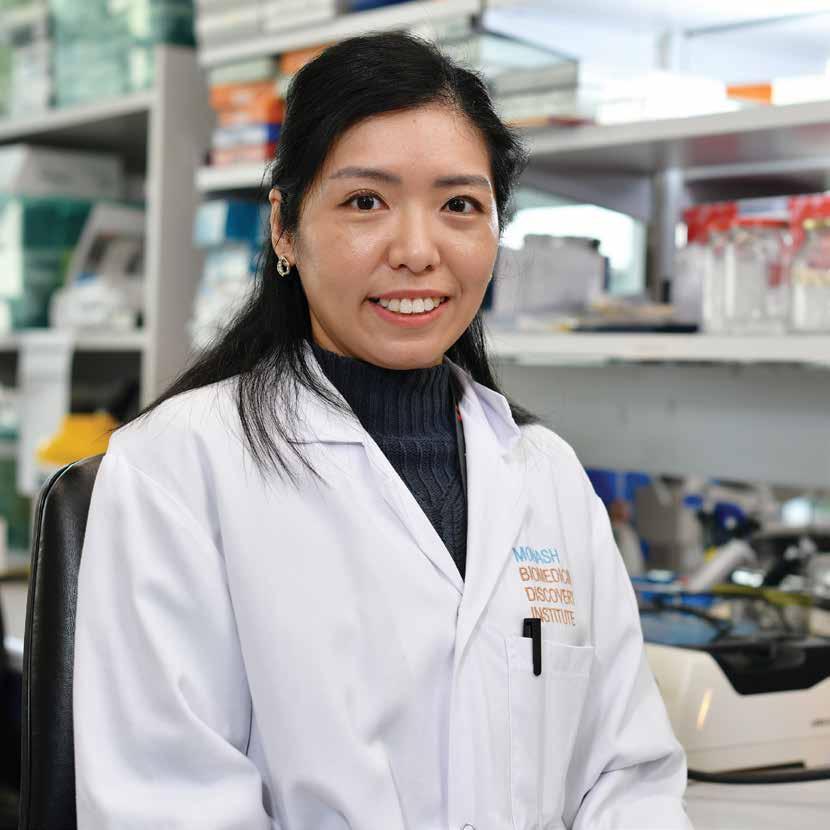















 Professor Stephen Jane Chair, Cabrini Scientific Advisory Committee
Professor Stephen Jane Chair, Cabrini Scientific Advisory Committee


























